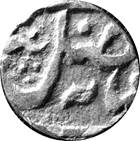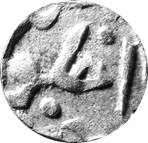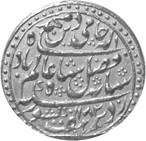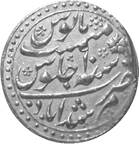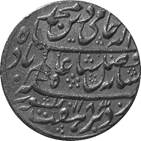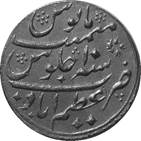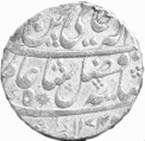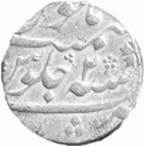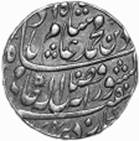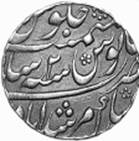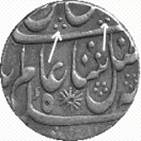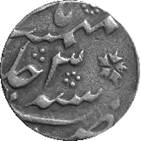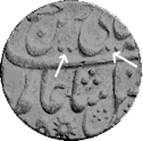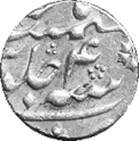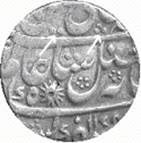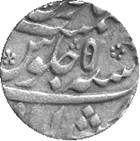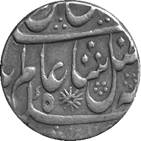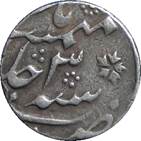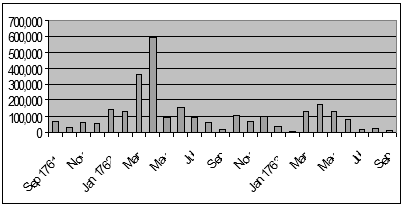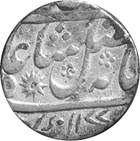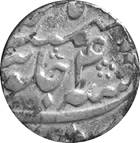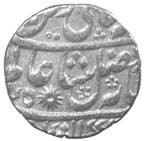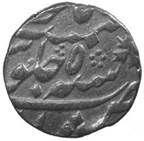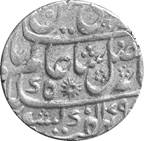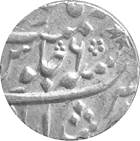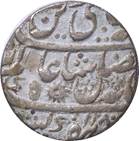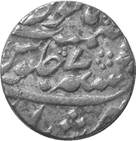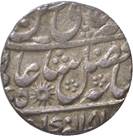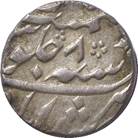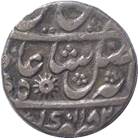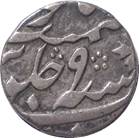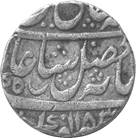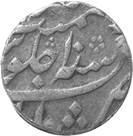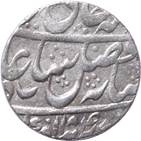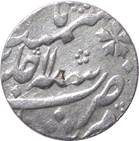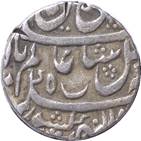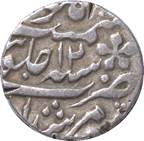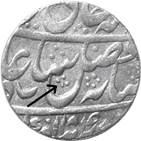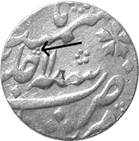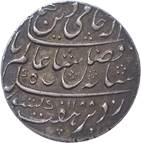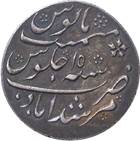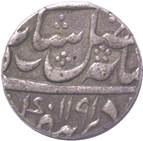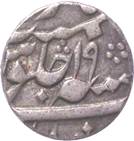Calcutta
Mint, 1760 to 1790
|
Summary |
By
the beginning of 1761, the Calcutta authorities had established a working mint,
and had attempted, unsuccessfully, to get the public to accept coins with the
mint name Kalkutta. They therefore had forced the Nawāb to allow them to
strike coins with the mint name Murshīdābād in their mint at
Calcutta. They began to do this from the beginning of 1761, issuing coins in
the name of ‘Ālamgīr II and, in the middle of 1761, followed this
with coins in the name of Shāh ‘Ālam II. In addition, they had
begun to strike Arkot rupees and, for several years Arkot rupees represented
the major output of the Calcutta mint. Having finally sorted out the types of
rupees that would be most useful, the Calcutta authorities faced another
challenge with the silver coinage, namely the scarcity of silver available to
produce such a coinage. The reason for this scarcity is somewhat obscure but
has been attributed to the desire of the EIC to become the dominant trading
partner of China, leading them to export large amounts of silver from Bengal
for the purchase of goods from that country. Another possible reason is the
export of silver back to Britain by the British residents of Bengal as they
accumulated huge fortunes to take home. It is also possible that the shortage
was caused by, or at least exacerbated by, the shroffs hoarding the metal in
the expectation that the price would rise. Whatever the reason, the
authorities were unable to obtain sufficient silver to meet the currency
demands of Bengal, and Robert Clive, the Governor, attempted to solve the
problem by creating a bi-metallic currency, issuing gold coins with a fixed
value relative to silver and with disastrous results for the Bengal economy.
A subsequent gold coinage proved more successful and continued until 1788. The second major challenge facing the All of these problems were exacerbated
by the extension of the Company’s power in In about 1770, with the issue of the
RY 11 rupees, all four mints in the Presidency were instructed to strike
identical coins, that is the Murshīdābād sicca, and this was
the first serious attempt to try to address the problem of batta. In the following year an
attempt was made to stop the other type of batta, which was charged on older Murshīdābād
rupees, by instructing the shroffs not to charge this exaction on RY 11 coins
once the RY 12 coins were issued. Both these efforts had limited success and
very few coins were issued in RY 13 and 14, with the mints of |
||||||||||||||||||||||||||||||||||||||||||||||||||||||||||||||||||||||||||||||||||||||||||||||||||||||||||||||||||||||||||||||||||||||||||||||||||||||||||||||||||||||||||||||||||||||||||||||||||||||||||||||||||||||||||||||||||||||||||||||||||||||||||||||||||||||||||||||||||||||||||||||||||||||||||||||||||||||||||||||||||||||||||||||||||||||||||||||||||||||||||||||||||||||||||||||||||||||||||||||||||||||||||||||||||||||||||||||||||||||||||||||||||||
|
The
First Gold Coinage, 1761 to 1765 In November 1761, the attention of the There being several
parcels of gold which the proprietors are desirous of coining in the
Company’s mint & there being at present no servants in the mint
acquainted with the coinage of gold The President is desired
to write to Muxadabad to procure such as may be
necessary and the Mint Master is sent for and directed to lay before the
Board an estimate of the charges of gold coinage in order that the charges
and customs thereupon may be settled in proportion to the silver coinage
which has already been done. Earlier, in March of 1761, a new Mint Master had been
appointed as revealed in a letter from Immediately on receipt
of your letter of 13th March 1761 we appointed Mr Beaumont to the
charge of that office, & we hope in consequence of our representation
last season you will send us out a capable Assay Master with all proper
utensils without which it is impossible that the fineness of bullion more
especially gold can be ascertained to a sufficient exactitude. These entries are the only ones found that refer to gold
coins during this period and it must be assumed that, if any coins were
struck, they would have been mohurs with the mint name
Murshīdābād. Only a few coins that would fit into this period
have been recorded and even some of these might be considered doubtful
Sixteenth
Mohur, possibly dated RY 2, 3 or 4. Not certainly from
Murshīdābād , although the style is right for this period The
Second Gold Coinage, 1766 to 1768 In
order to alleviate the problems caused by the shortage of silver, the In obedience to your
commands, I have now the honor to lay before you the plan adopted by the
Select Committee and approved by the Ministers for establishing a gold
currency to obviate the scarcity of money which so large an annual
exportation of bullion to China must necessarily produce. The scheme hath already
been intimated to the Honble the Court of Directors, not as an effectual
remedy, but a palliative that will obstruct the progress of the evil until a
more radical cure be discovered. To give such
encouragement to the importation of foreign gold, and advantages to the
natives, who hoard up and secrete this metal, as might induce them to apply
their useless treasures to the publick benefit,
were the great objects of the Committee. The difficulty lay in
fixing upon such a rate of exchange as should answer the intention of
bringing gold to the treasury without reducing silver below that natural
value which it bears in most kingdoms in Europe, since this circumstance
might be productive of inconvenience at home. Gold being mearly
a merchandize in Bengal, and the quantity of it already contained in the
country very uncertain, it was thought proper to make the mean rate of
exchange in Europe the principle upon which the following regulations for a
gold currency are calculated. Mr Campbell the Assay
Master being called before the Board reads the regulations proposed by the
Committee for establishing a gold coinage. Whereupon they observe it is
proposed that the par of exchange between the new
gold mohur and the silver sicca rupee shall 15 to 1, which they think too
considerable a profit to the merchants & prorietors
for bringing their gold to the mint, and are of opinion that the proportion
of 14 to 1 which will yield a premium above the par with silver about 8 per
cent, will be a sufficient encouragement to them for that purpose. The Assay
Master being thereupon directed to make the said alteration digests the whole
into the form of a letter which is ordered to be entered hereafter. The other
part of the regulation pointed out by the Committee being entirely approved. Ordered that the said
regulations be communicated to the Resident at the Durbar with directions to
put them into execution as soon as possible, and that public notice be also
given at this Presidency for that purpose. Mr
Campbell was asked to rewrite the proposal with the new gold to silver ratio
included, and he duly did this: 1.
That a gold mohur shall be struck bearing the same impression with the present
Murshīdābād sicca & that this mohur shall also be issued
in the subdivisions of halves, quarters and eighths. 2.
That the new coin shall be of the fineness of 20 carots;
or it shall contain 1/6th part of an alloy, which reduces it to Rs
16-9-4 per cent below the value of pure gold, to 13-7-7 below the mean
fineness of the sicca & Delhi mohurs, & to 8-2-2 1/3 beneath the
standard of the present Arcot gold mohur. The
reasons for fixing upon this standard are that it is deemed the most
convenient for allowing the proposed encouragement to the merchants & prorietors of gold, and likewise for avoiding the great
delay and expense of refining in a country where the process is not
understood and the materials for conducting it are obtained with difficulty. 4.
That the gold mohur shall be encreased from 15 anas, the present actual weight of the Arcot, to 16 anas, the better
to avoid the inconvenience of fractional numbers in the subdivisional parts,
and the exchange. 5.
That the par of exchange between this gold mohur
and the silver sicca rupee shall for the present be estimated at the rate of
14 to 1, reckoning upon the intrinsic value of either. Thus a gold mohur
weighing 15 anas shall be equivalent to 14 sicca
rupees. You
will perceive gentlemen, that a discount of 1 in 15 or 6-10-8 per cent is now
made on the exchange proposed by the Committee in order to obviate the very
reasonable objections which the Board made to the exhorbitant
profits assigned to the merchants & proprietors. 6.
That the silver sicca rupee shall not be less than the standard of 11 Oz 15
Dwt or 13 Dwt better than English standard whence will arise A
profit to the merchant of gold 3 per
cent A
batta on the gold mohur 3 per
cent A
charge for coinage and duties 2 per cent Total 8 per
cent which
increased value is calculated from the generally received exchange of gold
& silver, and not upon the market price of gold, which fluctuates daily. 7.
That all payment whether of a publick or a private
nature shall be made at the established batta, and that every attempt to make
an artifial batta or exchange shall be rigorously
punished. 8.
That a tender of payment either public or private shall in future be equally
valid in gold & in silver; and that a refusal of the established gold
currency shall incur such punishment as this Board may think proper to
inflict. 9.
That public notice shall be given to all Zamindars, Collectors of revenue
& others, that the collections may be made indiscriminately in gold and
silver, the former to be received at the mint & Treasury at the rate
proposed in the 2nd article, that is the sicca and delhi mohurs to be recoined with an alloy of 13-7-7 and
the Arcot mohur with an alloy of 8-2-2 1/3, which
will produce agreeably to the principle of exchange laid down, the advantage
proposed in article the fifth. These gentlemen, are the
articles proposed by the right Honble the President & the members of the
Select Committee, upon which I shall beg your permission to offer the
following remarks. The establishing a gold
currency in the country appears to me the only practicable method of
abolishing that pernicious system of reducing the batta on sicca rupees
annually. There being now a fixed standard of value for silver, that metal
must in time necessarily settle at the precise point which determines the
proportion it bears to gold. Neither will the scarcity of any species or
specie affect the batta, since the gold currency will always afford the means
of payment without loss by the exchange. The batta of the mohur being invariable,
will soon render that of the silver invariable also, or else the principle of
exchange will be destroyed, and of consequence the profit to the merchant
will become precarious. This effect, I think, must necessarily flow from the
full establishment of a gold currency, and were there no other advantage
attending it than the reducing to a first determinate value the great variety
of coin with which the business is distracted in this country, that alone
would be well worth the experiment. It will be absolutely
necessary that the utmost care be taken to prevent any debasement of the fixt standard of the gold mohur which is already rated so
high in the exchange. I should myself apprehend that a fraud of such
dangerous tendency to publick credit should be punished
with death; and as the English laws will not authorize so rigorous punishment
for adulteration of the current coin of I should likewise
imagine that severe penalties should be annexed to the secreting, defacing,
clipping or melting down the new coinage, & that the same together with
the punishment to be inflicted on every attempt to vary the batta or obstruct
the currency should be promulgated in every district of the Nabob’s
dominions. As
can be seen from the above extract, the design of the coins was to be the
same as the Murshīdābād sicca. Pridmore has assigned
Murshīdābād style gold coins with the letter C to this issue,
although he gives no reason for this attribution. The authorities had
difficulty with the shroffs discounting silver coins that could be identified
as coming from Pridmore
gives the meaning of the letter C as the initial letter of the word The
authorities were worried that the introduction of a fixed relative value
between gold and silver would drive even more silver out of their province: But, contrary to the end
proposed by this plan for stablishing a gold currency, it should encourage
the exportation of silver to the northward. It will be necessary to guard as
far as we are able against such a circumstance. Agreed therefore that it
be recommended to the Resident at the Durbar to procure proper orders to the
Chokies on the boundaries of these provinces strictly to prohibit all
exportation of silver. On
The regulations for
establishing a gold currency which were proposed and approved in consultation
the 2nd June having been publickly
advertised at the Presidency Ordered that the same do
take place at the several subordinates & that they be wrote to accordingly.
Also that the advertisement be entered after this consultation. By Order of the
President & Council, Notice is hereby given
that in order to obviate the inconvenience arising from the prevailing
scarcity of silver the Right Honble the President & Council have come to
a resolution to establish a gold currency upon the following plan That a gold mohur be
struck of the fineness of 20 carots and 16 annas in
actual weight which shall be received in all payments publick
and particular at 14 sicca rupees each. That for the convenience
and dispatch of business this coin shall be issued in the subdivisions of
halves, quarters and eighths which are to bear the same proportional value as
the mohur. By this par of exchange between gold and silver there will accrue
an advantage of 8 per cent on the actual value of gold and more in proportion
of its purity according to the medium of the market price on all mohurs, Chequins, Nadarees, gold ingot
[Dush] etc that shall be brought to the treasury, which is intended as an
encouragement for the importation of that metal. In consequence of these
measures for establishing a gold currency, the publick
revenues and all payments to the Honble Company will be received
indiscriminately in gold and silver, and a tender of payment in all money
transactions both publick and private shall be
equally valid in the new gold mohur as in any species of silver rupees. It appearing to the
President & Council that many advantages will result to merchants and the
publick in general from the foregoing plan, it is
hereby directed to take place from this day, and the Mint Master and
sub-treasurer are accordingly directed to receive all gold offered to coinage
or payment after the same hath been assayed and the value settled to the
satisfaction of the merchant agreeably to the above regulation. Notice is hereby given
that any person or persons discovered in attempting to make a variation in
the exchange between gold and silver or in obstructing the currency of the
new coin by refusing to accept it in payment, if natives they will be
delivered up to the Government to be punished with the utmost severity, if
Europeans they will forfeit the Company’s protection and be sent to England
forthwith. Any person or persons
detected clipping, melting down the new gold currency or attempting the
exportation of silver to the northward will also be subject to the penalties
aforesaid. At
the end of 1767, Mr Campbell made his final report to the Calcutta Council,
before resigning his post. His report gives some interesting observations on
the gold coinage [6]: …In the coinage of gold
I have been less successful nor can any material alteration be made without
effecting […] change & refining as they do in Europe by means of spirit
of [nitrate?] or antimony which in my opinion will not answer upon the amount
of the expense of sending out materials and the danger which will attend the
process amongst an ignorant careless sort of people. It was for this reason
the Board thought proper to fix the new gold mohurs at so low a standard as
might in general avoid the necessity of refining… Having accomplished all
that was proposed when I took charge & deposited with Mr Bentley the
fullest instructions upon every difficulty that may occur, I am to request
your permission to resign the assay office to that gentleman […] in the space
of three years during which he acted as my assistant he has acquired so
perfect a knowledge of the business as will enable him to conduct it to your
satisfaction. The mint being entirely
cleared and all payments made and accounts brought up to this day, I must
also request your leave to resign the employment of Mint Master & the favor of your directions to whom I shall deliver over the
charge of the office. I have already
acquainted the Honble President and the members of the Select Committee with
the necessity I am under on account of my health & the circumstances of
my affairs of proceding this season to Agreed that he be
permitted to resign his employments of Mint & Assay Masters & that Mr
Alexander be appointed to take charge of the former & Mr Charles Bentley
the latter. Mr Campbell’s ill state
if health rendering a longer stay in India dangerous to him he has requested
our permission to resign your service, which we have accordingly granted
& he now proceeds to Europe with his family on the Europa – we beg leave
to take this opportunity of recommending him to your notice for his
indefatigable attention to the business he was engaged in. He has been succeeded in
the employ of Secretary to the Select Committee by Mr Floyer
& in that of Mint Master by Mr Alexander & in that of Assay Master by
Mr Bentley. In
March 1768, We shall be anxious to know
the effect of your measures for establishing a gold currency; many of the
arguments contained in Mr Campbell’s letter appear to us to admit very
different conclusions than those he draws, the raising the comparative value
with silver beyond the established rates must infallibly tempt the
neighbouring countries to give you their gold for your silver and the
prohibition of the exportation of silver ordered by the Government can never
check it – silver lays in too small a compass to be restrained by any examination
and yet the pretence for such an examination may be productive of the most
grievous oppression and obstruction to the commerce of the country – the
argument of drawing forth hoards of gold into
circulation is equally liable to refutation, the principle on which it is
concealed is the fear of the strong hands of power, nothing can counteract
those fears but a thorough confidence in the mildness and justice of
Government. Of all the means proposed by Mr Campbell there is only one that
appears to us founded on general experience, and that is the receiving of
gold in payment of the revenues, for there is nothing but the freedom of
circulation can encourage it and all force in matters of commerce are always
ineffectual. The fixing the value of
rupees has always been what we have earnestly desired, and the only mode of
doing it appears to reduce the imaginary value of a new sicca. To conclude we
are very apprehensive of ill consequences resulting from overrating the value
of gold, if it should prove an error the sense of it must not check you from
reversing the order and reducing the price to its just value. We are unwilling to
impute any sinister views to any measure our servants have adopted for our
benefit, but the weak arguments urged in support of the establishing this
gold currency give too much reason to apprehend there may be some foundation
for the assertions that have been made in a General Court of Proprietors of
great advantages made by individuals on the sudden rise in the price of gold. We are pleased to find
Mr Campbell has conducted himself to our satisfaction in the office of Assay
Master and you must inform us if there are any of our servants training up to
be fit to succeed him in that office, agreeable to the directions we gave
when Mr Campbell was appointed. On
the 18th May 1768, the new Mint Master, James Alexander, wrote to
the Calcutta Council about the problems that the public were encountering
with the new gold coinage [9]. In
essence the fineness of the gold coins had been reduced because the mint had
no skills to refine gold and silver had risen so much in value that a gold
mohur had become worth less than 14 rupees. Yet the law stated that a gold
mohur was worth 14 rupees and the public demanded this from the shroffs. Not
unnaturally, the shroffs refused to meet these demands. The many complaints that
are made me by the shroffs from my employment as Mint Master, of people
forcing on them in a violent manner gold mohurs and demanding for each 14
sicca rupees, the general distress of the inhabitants for want of a
sufficiency of silver currency to procure the common necessaries as well as
to carry on their commerce, and the dread of this evil still increasing,
occasions my troubling you with this address and not doubting if possible but
you will fall on some mode of rectifying the same. The gold mohurs
notwithstanding the positive order of the Government that it should produce
14 sicca rupees now sells publickly in the bazar
for 13 rupees 12 annas. When I demand of the shroffs the reason of their
disobedience in refusing them at the fixed rate they declare it is entirely
out of their power from the high price of silver but that they are ready to
pay into the Treasury any quantity of gold for silver & that they will
afterwards deliver it out at the same exchange they receive it. What they alledge appears to me so very reasonable that I do not
see how they can with propriety be forced to exchange silver at a stated rate
unless they are supplied with that article in such a manner as will answer
the purpose. I have counciled the principle inhabitants to know if they could
point out any method that would render the currency of gold more general.
They assure me they know of none and recommend stopping future coinage but
that in case the Government are still resolved on its continuance they would
then advise the mohur being made of the same fineness as formerly. At present
being 1/6th of an alloy all ranks of people consider an idea from
the gold mohurs not being quite pure that it is deficient in its intrinsic
value and will exchange at any rate rather than hoard them up with a view to
carrying them off in times of danger for which purpose alone they were
formerly coined, whereas when they are pure gold they will be more induced to
receive them through the kingdom of Bengal in order to conceal them or to
manufacture into jewels from a certainty of their being always of such a
value. I am of opinion that
fresh orders to the gentlemen who have the collection of the revenues, to
receive them with the same readiness as silver, might assist much their
currency. At present they pass
nowhere out of the town of Calcutta unless at a very great discount. The
Calcutta Board were obviously worried about this problem and decided at the
same meeting that the production of gold coins should cease: The Board having taken
into very mature consideration the subject of the Mint Master’s letter and
being fully sensible with him of the necessity of remedying this evil that is
to be apprehended will still increase, are of the opinion that the first step
to be taken to stop its progress is to prevent any more gold mohurs of the
new currency being coined. Agreed and resolved
therefore that no more of the mohurs be coined in our mint & that the
Mint Master be acquainted with this resolution & at the same time desired
to inform us as soon as possible what quantity have been coined in the mint
since the currency first took place. Agreed also that this
resolution be communicated to the Resident at the Durbar and Chief of Patna
& the same questions issued to them as has been given to the Mint Master
here. On
the 13th June the Resident at Murshīdābād stated that no more gold coins would be
struck and that about 70,000 had been produced in total [10]: …and that he has also
informed the ministers with our desire that no more gold mohurs should be
coined at the city. That since the commencement of the currency there has
been about 70,000 coined and
on 27th June, Patna also informed Calcutta that they had stopped
production of the coins [11]: … transmitting us an
account of all the gold mohurs of the new coinage currency which have been
coined in that mint since their first establishment acquainting us also that
the coinage of those mohurs has been stopped from the 4th of
November 1766 & shall remain so until further orders… Finally
on the 1st September 1768, the President summed up all the
problems encountered with this gold coinage [12]: The many and great inconveniences
resulting from the establishment of our gold currency have for some time been
the objects of my most serious consideration; and I flatter myself that the
measures already adopted by the Board, of stopping farther coinage, receiving
part of the revenues in that specie, and occasionally remitting it to Madras,
would have removed or at least mitigated the most material causes of
complaint. I now however perceive that instead of a diminution of the old
evil, new ones are daily presenting themselves; and that our public credit
and the funds for our investments begin to be sensibly affected. It now
therefore becomes essentially necessary that the Board should take the matter
under their most attentive deliberation; and as I must request the several members
opinions concerning the most effectual remedy for so alarming a circumstance,
I will embrace this opportunity of laying my own sentiments before them. The
principle advantages originally proposed by the institution of a gold
currency were 1st to curb the impositions of the shroffs in their
arbitrary rise and fall of batta by establishing a coin which should bear
everywhere a fixed value. 2nd to encourage the import of gold by
putting a current value upon it considerably above its real one and 3rd
to prevent the exportation of it, from the certain loss of that established
advance. How little the first of these purposes has been answered will appear
from a reference to the state of the batta in the bazar for some months past.
Instead of a fluctuation as formerly of one, two or three per cent the silver
rupee has risen from 8 to 42 per cent above par; and by that means the power
of the shroffs [yra?] to impose, has been encreased in an equal proportion. The consequence of this
both to trade and revenues is obvious; the first becomes loaded with a
discount at a medium of 10 per cent, as no thing
but silver was received in payment here; and in the second case the [renter]
was glad to avail himself of the advantage by exchanging the silver rupees he
collected for mohurs in the bazar, and deriving to himself thereby a gain of
10 per cent on the amount of his payments. Much of the silver therefore which
would otherwise have come into the Treasury was diverted into the hands of
the shroffs, who either secreted it to keep up the batta, or sold it at an extravagent premium to those whom necessity obliged to
make remittances through the Dutch and French [Cashl],
because they could not obtain bills on their own Company, and because those
nations positively refused to receive any other species but silver. The Treasury it is true
issued the mohurs in their disbursements at the established rate, but how
much to our dishonor must clearly appear from the
above mentioned rate of batta as every servant of the Company in Calcutta,
both European and Native, received their pay in a specie which they could not
apply to their ordinary expenses without losing one tenth of the whole.
Fortunately the evil had not proceeded so far at the time of our last years advances; but should it continue I cannot see how
we shall find silver to send to the Aurungs for the
next, except we subject the Company’s trade to the same tax as that of
individuals has been, by exchanging the mohurs at the current batta of the
bazar. The second and third ends
indeed have been accomplished; but instead of advantage, have been productive
of the most essential detriment. It is a certain proposition that the
particular encrease of any species of coin will
either sink its own value, or, what is in fact the same, raise that of the
other current coins, which may be in a smaller proporation.
If this surplus cannot be exported without loss, the evil becomes more
difficult of cure, and of the higher value the species of coin is, the more
severely it will be felt. If we apply this to ourselves, it will clearly
evince that the encoragement to import, and the
losses fixed on the exportation of gold have been so far from benefiting us
that they have been of very [general] disservice and only loaded us with the
superfluity of a coin the least calculated for trade or general circulation. Thus situated, a speedy
remedy becomes absolutely necessary, but this remedy must be attended with
loss and the only question is whether that loss might fall on the Company or
the community. The general practice of other governments in similar cases
does not I believe afford a precedent for the latter measure but whenever
necessity or policy has occasioned any coin to be debased, and from
considerations equally important the former standard reestablished,
the deficiency always fell on the state and not on the people. The
records go on to describe what will be done to resolve the matter: Agreed and resolved to
abolish this establishment of the gold currency and annul the orders of the
Select Committee regarding it, and for the space of 15 days ensuing from the
publication of this resolution to receive into the Treasury all gold mohurs
of the late currency at the full rate of fourteen sicca rupees, their
original fixed value, and for every amount of the same above the sum in and
value of one thousand rupees to issue interest notes payable in or within the
space of twelve months which said notes are to bear an interest of 8 per cent
per annum from their respective dates, and that no gold mohurs so received
are to be again issued out of the Treasury… and
the number of gold coins produced at each mint was given [13]: Total
of Gold mohurs coined in the following mints In
Calcutta 177871 Patna 15974 Moorshedabad 70000 Total 263145 Sent
to Madras by different conveyances 134417 Balance 128728 In
fact, the actual number struck at Murshīdābād seems to have been slightly different than
that given above [14]: Received a letter from
the Resident at the Durbar dated the 20th July transmitting us
conformably to our directions a particular account of the number of gold
mohurs coined in the mint at Moorshedabad which
amount to 78,785 So,
in short, the Calcutta Government was obliged to recall the gold coins at the
rate of 14 rupees to the mohur, but it had to issue promissory notes to those
applicants with 1000 rupees-worth or more of mohurs, because there were not
enough silver rupees in the treasury to pay for all these gold mohurs.
Interest then had to be paid on the promissory notes. On
the 13th September 1768, Calcutta wrote to London about the
failure of the gold coinage [15]: We acquainted you in a
cursory manner in our letter of 22nd Novr.
Para 57 that we had been disappointed in our motive for establishing a gold
currency. We then informed you we were apprehensive it would not obviate the
scarcity of silver. We are sorry to say these apprehensions were but too well
founded and in these sentiments we were confirmed by a minute of the Mint
Master entered in our cons of the 4th The consequences of this
currency were greatly complained of. It was pointed out as the immediate
source of a general evil. The interruption trade had met with, the
inconvenience under which the merchant had laboured from the great scarcity
of silver & high price it bore. The many and pressing complaints which
were made of the grievances accruing both to trade in general & to
domestic expenses in particular were all effects attributed to this cause. The necessity of
removing this public burthen as soon as possible & the obvious
consequences these alarming effects would encrease
whilst the cause existed made us earnestly wish to put a stop to the
currency, but we were obliged to defer our resolutions until very lately.
Earlier in the season we could not carry into execution our earnest wish to
put a stop to this great evil for want of silver currency. Till the present
time we were sensible we could not expect any considerable surplus of silver,
there being but very small sums received [on] acct. the revenues from March
to Septr. But we may now flatter ourselves with
silver to a large amount being soon paid into your treasury thro’ that
channel which we hope will enable us to make the necessary payments, &
promote a circulation essential to the trade of the place. In the 59th
para of your general letter of the 16th March you removed from us
the only doubt which existed concerning the expediency of recalling this gold
currency since we were fully convinced of the necessity of adopting such a
measure & [were?] only withheld from carrying it into execution from the
consideration of the loss which would ensue to our employers. Happy to find that your
generous mode of thinking on this subject had enabled us to relieve the
colony from the hardship under which it laboured & willing to demonstrate
our hearty desire & earnest endeavours to remove them, we came to the
resolution of calling in all the gold mohurs of the new currency &
abolishing the establishment & of giving interest notes payable at the
expiration of twelve months for all sums above & of the value of 1000
rupees paid into the treasury within the space of fifteen days after the
publication of this resolution. We were induced to limit the period of
fifteen days from an apprehension that there were private mints who might
take the advantage of this juncture to encrease the
coinage. London
was pleased that the problems of the gold coinage had been resolved [16]: The mischievous
consequences of your project of a gold currency to be established upon an
arbitrary valuation have proved to be such as we have foretold by our former
letters, and we are glad to find that you opened the treasury to receive them
back for a course of fifteen days, notwithstanding the great loss which has
thereby fallen upon the Company, we see with concern the distress and injury
which the trading part of the country have suffered by this ill founded expedient. You are to consider
silver as the only measure of commerce in Bengal, gold though it may be
coined, must not have any fixed value set upon it, but must be always
considered as bullion and left to find its own value in the market. We see in so strong a
light the dangerous consequences of making any alteration in the standard of
the coin of the country, that we do most positively direct you do not
(without our previous and express orders) under any pretence whatsoever
presume to make any alteration in the original and established standard for
weight and fineness of the gold mohurs and silver rupees which may from time
to time be coined in our mint at Calcutta, and whoever shall be guilty of a
breach of this order will incur an immediate dismission from our service. That we may be satisfied
that you keep up to the standard, the Assay Master is every three months to
take out of your mint, musters of the different species of new coinage of
which he is to make an assay and report the same to you, which report is to
be entered on Consultation for our observation, you are likewise strictly to
conform to our orders in the 62nd paragraph of our letter of 11
November last for taking out musters of coinage from your mint and sending
them annually to us. Not
content with the failure of the previous gold coinage, a few years later the
Calcutta authorities determined to try again. Of course, they were different
people, Clive had left and was replaced by Verelst,
and they would do it better than the last lot! On
the 20th March 1769, the Armenian merchants in Calcutta suggested
that a new gold coin should be issued and the Calcutta Council agreed with
this and determined to issue a new gold coinage this time composed of single,
half, quarter, eighth & sixteenth mohurs, but of a higher intrinsic value
[17]. The
Nawāb was asked for his opinion and he responded positively [18]: Received a letter from
the Governor & Mr Becher dated the 20th April 69 enclosing a
letter from the Governor to the Nabob recommending to his consideration the
proposed plan of a gold coinage for the relief of the distress occasioned to publick & private business from the want of specie in
the country, & the Nabob’s answer to it and informing us that this plan
has met with the general approbation of those whose experience & understanding
in this branch is well known. That as soon as the new mohurs are struck they
will send us specimens of each size in order that the exact proportion of
weight and fineness may be ascertained, & in the meantime publick notice will be issued by the Government to
foreign nations & throughout the provinces of the establishment of the
new currency, and as the distress of individulas
almost approached to general bankrupcy & the publick revenue would in all probability have soon felt
the effects of a growing evil, they are in a particular manner flattered by
the general voice & sentiment in favour of the measures to be taken for
its relief. Agreed that we
acknowledge receipt of their letter & inform these gentlemen that we feel
very particular satisfaction at the general approbation expressed of the
intended new coinage so necessary to restore a currency to trade &
relieve the country from those evils which
naturally proceed from a want of specie, that we request they will
promote the coinage & help the circulation of the new mohurs by all the
means in their power as the distresses occasioned by the want of it increase
daily, & desire they will send us stamps of the several new coins as soon
as possible as we wait for them to serve as models for our new coinage in
Calcutta. It
is clear from this letter that the dies were prepared in
Murshīdābād and later sent to Calcutta. London
was informed of the new project almost immediately in March 1769 [19]: To relieve the universal
distress the settlement has felt for want of specie and to remedy so alarming
an evil has for some time past been the subjects of our deliberations. After having duly &
maturely weighed this matter, & having concerted the principal banians,
bankers, merchants & the ministers of the Nizamut
we came to the resolution of recommending to the Nizamut,
the establishment of a new gold currency... …In justice to the
integrity of the members of the administration who established the late gold
coinage we here beg leave to assure you we cannot suppose they were induced
to adopt the measure from any other motive than a full conviction that it
would be of advantage to the publick and was an
expedient to stop the progress of an evil severely felt and loudly complained
of or that they were biased or influenced in the smallest degree by any
private advantages. It is probable the
inexperience of these gentlemen on such a subject might lead them into some
mistaken notions, from whence their arguments might, as you observe, appear
weak, & which perhaps gave rise to a severe remark you acquaint us was
made in a General Court of Proprietors. In the present establishment however
that we have recommended we hope we have fully obviated even the shadow of
censure or reflection by the equitable proportion we have observed between
the value of the gold & silver which is nearly equal to what it bears
[in?] all countries of the world. And
in April 1769 Calcutta reinforced this message [20]: As a present relief to the
necessities of the settlement, at their universal request and to supply as
far as possible the deficiency of silver for the purpose of trade and
revenue, we have found it expedient to re-establish the gold coinage upon a
new plan and standard as the only remedy left us, and I doubt not that when
you seriously weigh the arguments set forth in the resolutions of the Board,
you will approve the measure and acquit us from all imputation of
precipitancy or contradiction in our councils. Specimens
of the new gold coins arrived in Calcutta from
Murshīdābād on 8th
May 1769 [21]: Read, the following
letter from the Mint Master (Charles Floyer) Having received from the
Governor samples of a new gold mohur and its divided parts which the country
government deems most likely to effect the salutary effects proposed by this
Board in the establishment of a new gold currency, I have now the honor to
lay them before you together with a letter from the Assay Master on the
subject, for your determination. The
Assay Master’s letter begins: In consequence of your
directions I have assayed the gold mohurs & their divided parts which
have been lately coined in the mint at Moorshedabad… Read also the following
extract of a letter from the Resident at the Durbar, to the Select Committee
dated Some mohurs of the new
gold coinage were received yesterday in part of the [poonkah
Kists] & the ministers will immediately issue
strict orders for receiving, in all the districts, gold when offered in
payment of the revenues and I hope the currency will be established without
difficulty. In
September 1769, Calcutta reported to London that the new gold coinage was a
success [22]: We informed you in our
letter of the 28th March that to relieve the universal distress of
the settlement on account of the want of specie and to remedy this alarming
evil we had determined to recommend to the Nizamut
the establishment of a new gold currency. We are now to acquaint you that
this measure hath taken place and that we were informed by the Governor and
Resident at the Durbar soon after it had been established that the mohurs
which had been struck at the mints of Dacca, Patna & the city had met
with a ready circulation & were received with general satisfaction. It
would seem from this extract that the new gold coinage was struck initially
at the mints of Murshīdābād, Patna and Dacca. No coins are
known of the Dacca mint for this coinage. Murshīdābād and
Patna coins were of the following type:
Murshīdābād
Mohur
Patna (Azimābād) Mohur London
was sceptical of the possibility of success of this coinage [23]: Having already given our
sentiments at large upon the subject of the former gold currency and the
institution of another as mentioned in your general letter of the 28th
March 1769 and in the Consultations the 20th of the same month,
being of great importance, we do not choose to give any particular directions
thereon, as we shall refer this matter to the determination of the
Commissioners. But, in general, we fear no regulation can accommodate the
country with specie, as you say the inconvenience arises from the real want
of specie in the province. At present we see no other objection to its being
put in practice, except the smallness of the pieces of gold of less value
then two rupees, because the smallness of the piece will subject it to loss,
and as the Company must receive them on account of the revenues, if there
should be any false coinage, it would ultimately fall on the Company. Calcutta
wrote to London in 1770 [24]: …With regard to the gold
coinage which we have before advised you was established in order to
alleviate the general distress of the merchants arising from the great
scarcity of silver specie that prevailed, we have the pleasure to inform you
that it hath in some degree answered the desirable end; and as the coin hath
from its purity been universally esteemed and received with general
satisfaction, we flatter ourselves you will not disapprove our conduct in
suffering the present establishment to remain untill
we are honored with your sentiments in answer to
what we have already written on the subject. This
gold coinage continued until the end of 1788 in the Calcutta mint, the other
mints having been closed before then (see chapter 6). In 1788, the Mint Master, Herbert Harris was asked to
report how many gold coins he could produce in a given time. He reported in
April [25]: I have received your
letter of the 16th and have to inform you that I can with ease
strike in the course of a month sixty thousand half gold mohurs and sixty
thousand quarter gold mohurs equal to the sum of sicca rupees 720,000, and
that the half of the sum may be struck monthly without interuption
to the current business as the coinage seldom exceeds 150,000 per month
unless bullion is brought in from foreign nations. Ordered that 50,000 gold
mohurs be coined into small pieces of the following proportions as soon as
possible Pieces Amt Gld Mohurs Half Gold Mohurs 20,000 10,000 Quarter ditto 88,000 22,000 Eighths ditto 143,200 17,900 Sixteenths ditto 1600 100 Ordered that the
sub-treasurer do make advances to the Mint Master on this account in such
sums as he may require, and the state of the treasury will admit. In April 1788 the Mint Master added further opinion [26]: The objection Your
Lordship did me the honor to communicate yesterday against the coinage of
small gold, by its effects tending to distress the lower order of the
inhabitants will, I imagine, will have little weight when it is considered
that the servants and labourers (except in some few instances) are either
paid in gold or in silver with the batta deducted and it is obvious that an
increase of small gold money would lessen the demand for silver and in
consequence reduce the batta on exchange. Permit me with the
greatest diffidence, to submit to your Lordship’s consideration, whether a
gold coin of the value of one sicca rupee would not be of the greatest
utility in the districts. The manufacturer would
willingly take it, if he was certain it would be received in the revenue by
the zemindar and farmer, and no reasonable
objection could arise on the part of either of them if its currency was
admitted in every office of Government, supported by the authority of the
collectors and superintendents of the Khalsah and
promoted by their example. The strong conviction I
have that the present rate of exchange if the effect of artifice and
chicanery and not of absolute scarcity, warrants me to assert that the batta
would be reduced nearly to par before the sum issued shall amount to fifty
thousand gold mohurs. Resolved that the 50,000
gold mohurs ordered to be coined into small pieces on the 21st
instant be reduced to the following
proportions instead of those directed on that day Half gold mohurs 10,000 ¼ ditto 16,000 1/8 ditto 8,000 1/16 ditto 16,000 The
coinage of gold was suspended in December 1788 [27]: Ordered that an advertizement be issued in the English, Persian and
Bengalese languages, in tomorrow’s gazette, notifying that from and after the
present month the coinage of gold mohurs will be suspended, and no more gold
bullion will be received at the mint. Also that gold mohurs which have been
coined in the Calcutta mint will be recoined into small gold mohurs for the
convenience of individuals without any expense to them, and weight will be
delivered for weight. Ordered that the sub
treasurer be ordered to make his future payments in proportions of silver and
gold according to the quantity of both in the treasury at the time. This
was the last coinage of gold until after the introduction of machinery into
the Calcutta mint Two
types of silver coins were produced in the Calcutta mint, the
Murshīdābād sicca rupee and the Arkot rupee, which was used
mainly in East Bengal. In addition, the Calcutta mint continued to strike
nazaranas with the Kalkutta mint mark for a few years. Each of the other
mints in Bengal also produced their own rupees: Murshīdābād
produced the Murshīdābād sicca, which was meant to be
identical to the Calcutta produced coin, Patna produced its own distinctive
rupee, as did the Dacca mint. The coins of Patna and Dacca are discussed in
chapter 7, as are many aspects of the Murshīdābād mint. 2
Sun Sicca Rupees (Nov 1760 to Nov 1761; AH 1174 to 1175) As discussed in the previous chapter, in July 1761, the
Calcutta Council received notice that the Nawāb had begun striking coins
in the name if Shāh ‘Ālam II, regnal year 2 and they agreed that
coins issued from the Calcutta mint should follow suit. As with the
‘Ālamgīr rupees, the question arises, how to distinguish between
those coins struck at Murshīdābād and those struck at
Calcutta? A normal Murshīdābād
rupee is shown below:
Normal
Murshīdābād Rupee of
Shāh ‘Ālam II, RY 2 (Photo from Nick Rhodes) However, a very rare rupee exists with a somewhat
different style, much more like the earlier Calcutta mint coins, and this
coin probably came from the Calcutta mint although, once again, this is, to
some extent, speculation:
Murshīdābād
Rupee of Shāh ‘Ālam II, RY 2, with Unusual Arrangement of Legend. (Photo from Shailen Bhandare) Nick Rhodes (personal communication) has found that coins
of the early years of Shāh ‘Ālam II might have been marked with
different groups of dots and it is possible that these represent the
different mints.
Rupee of Shāh ‘Ālam II, RY 3
Rupee of Shāh ‘Ālam II, RY 4
Rupee of Shāh ‘Ālam II, RY 5 The three pictures above show that different coins have
different dot arrangements in the top line of the obverse. The first has two
dots to the right and three to the left, the second has two dots to the right
and two to the left, and the third has three dots to the right and two to the
left. The full set of information discovered so far is given in the following
table: Regnal year 2 2 dots right 3
dots left Regnal year 3 2 dots right 2
or 3 dots left Regnal year 4 2 dots right 2
or 3 dots left Regnal year 5 and later 3 dots right 2
dots left Regnal years 3 & 4, at least, have two sets of patterns,
though which might represent which mint (if any) is not known. More
information is required to help address this issue. By September 1761, the dies for the
Arkot rupees had been received and it was resolved that from then onwards the
army would be paid in Arkot rupees. This, as well as the fact that the Arkot
rupees had become the accepted medium of exchange in several parts of the
Presidency (e.g. Chittagong) explains why the Arkot rupee became the major
coin produced in the Calcutta mint for the next few years [28]: As Arcots
will pass current at Dacca, Luckypore and some of
the Aurangs equal with the Sicca, there will yet be
a gain of 7 per cent by employing the Arcots on all
such occasions and it is therefore resolved to pay the military in future in Arcots instead of sonauts,
which through the scarcity of the other specie have
been used for some years past without any deduction of batta so this will be
a further considerable saving. Ordered therefore that
the Mint Master coin all the short wt Arcots with all possible expedition, and that he take all
opportunities of purchasing bullion for that purpose 3 Sun Sicca Rupee (Nov 1761 to Oct
1762; AH 1175 to 1176)
In January 1762, the Calcutta Council was informed that the
Nawab had begun striking coins showing the third regnal year of Shāh Alam II, and they resolved to follow suit, starting on 20th
February. In the meantime the Treasury was ordered to send all two sun siccas
to the mint for re-stamping into three sun siccas before the 20th
February [29]: Three sun siccas having
been struck at Murshedabad agreeable to the notice
before given us by the Nabob as per Consultation December. Agreed that three sun siccars be issued in our mint and become current the 20th
of next month. That advertisement be made thereof, and that two suns will be
reduced to thirteen per cent and all others to sonauts. Agreed that the
Committee of Treasury be directed to deliver to the Mint Master all the two
sun siccars to be restamped into three suns and that the Mint Master be directed to get as many
struck as possible against the 20th February. The Mint was not able to coin all of the money sent by
the treasury because of the additional work generated by private people
asking for their money to be recoined. It was agreed that the mint should
concentrate on the requirements of the Treasury and that private individuals
would have to wait [30]: The Mint Master
representing there is a vast quantity of money delivered to him from the
Treasury to be recoined in order to prevent the loss of batta, which it is
not in his power to get done while private merchants send in money daily to
be recoined also. Ordered him to defer
coining for the private traders till he has finished the whole of the
Company’s money delivered him from the treasury to be recoined. The large amount of work undertaken by the mint is shown in
the output figures published sometime later. A clear peak can be seen in the
graph in March and April 1762 [31]
Mint
output from September 1761 to September 1763 By May, most of the coins from the Treasury had been
re-stamped and the mint was re-opened for private traders. 4
Sun Sicca Rupee (Oct 1762 to Oct 1763; AH 1176 to 1177)
In December 1762, the Calcutta Council was informed that
the Nawab had started striking four sun siccas and, as with the two sun
siccas, it was decided that the three sun siccas should be sent to the mint
for re-stamping as four sun siccas and that from 1st February, all
new coins would show the fourth regnal year [32].
Before this work was started, the Council reconsidered the practice of re-stamping
coins and it it clear from the entry in the records
that up until that time the practice had been to literally re-stamp the old
coins i.e. use the old coins as blanks. This caused the coins to have a
larger diameter and to be thinner than those struck at the
Murshīdābād mint. They
could therefore easily be recognised and were not so easily passed in
currency. It was therefore agreed that henceforth the coins should be
re-coined, i.e. melted down and then re-coined. [33]: The Board now taking into
consideration the practice of re-stamping rupees in the Company’s mint, and
the many complaints made thro-out the country
regarding the Calcutta Siccas, apparently owing to the custom of re-stamping,
which as it draws the rupee broader & thinner & leaves the stamp less
perfect & distinct, renders it very [easy to] distinguish them from the
rupees struck at Moorshedabad, & obstruct their
currency – think proper to prevent in future the many bad effects, which
arise therefrom, to call upon the Mint Master’s opinion concerning the
expense of recoining siccas… It is therefore agreed
to abolish the custom of re-stamping & instead thereof to recoin in the
mint all rupees of the sicca standard at the rate of 2 ¼ per cent – whereby
there accruing a profit of 14 annas Ordered that eight annas
thereof (the same sum that was gained by re-stamping) be paid to the Company
– and the remaining six annas to the Mint Master In 1763, the British deposed the existing Nawāb and
replaced him with ‘the Old Nabob’, Jafir Khan, whom
they had deposed some years earlier. In July he signed a treaty that included
a commitment to ensure that the Calcutta coins passed equal to the
Murshīdābād rupees [34]: 9thly I will cause the
rupees coined in Calcutta to pass in every respect equal to the Siccas of Moorshedabad without any deduction of batta and whosoever
shall demand batta shall be punished. Despite the fact that Calcutta had switched from minting
the rupees with the mint name Kalkutta to those with the mint name
Murshīdābād , rupees
with the mint name Kalkutta exist dated AH 1175, RY 3 and AH 1176, RY 4. Both
coins are very neatly struck and were almost certainly produced as
presentation pieces. 5
Sun Sicca Rupee (Oct 1763 to Oct 1764; AH 1177 to 1178)
In January 1764, the Nawāb informed the Council that
he had begun striking 5 sun siccas in his mints of Murshīdābād
and Patna, and Council agreed that from the 25th February, the
same regnal year would be put onto the coins of the Calcutta mint. Mr Beaumont had ceased being Mint Master late in 1763 or
early in 1764 [35]
and had been replaced by Mr Middleton. He lasted less than a year and by
October 1764 in was agreed that Mr Marriott should take up the post [36]. For
some reason this never happened and in November Mr Leycester
applied to be appointed Mint Master [37].
However, there seem to have been a number of problems with the mint during
1764, not least was a complaint from the Nawāb that the Calcutta coins
were inferior to those of Murshīdābād [38],
although this was shown to be untrue [39].
However, the President of the Calcutta Council (Vansitart)
considered that the mint should be put onto a more professional basis and
that the Assay Master, Mr Campbell, was the only person capable of
understanding the processes needed to achieve this [40].
Campbell was asked to prepare a set of regulations for controlling the mint
although Mr Leycester was appointed Mint Master in
the meantime. Within a few days Campbell had produced his suggested
regulations [41]
and by 22nd of November he had been appointed Mint Master [42]. The
proposed regulations were as follows: 1.
That books be kept open in the Assay office at regular stated hours in which
shall be entered the receipt, delivery, assay and produce of all moneys sent
to the mint, in so easy and distinct a manner that every proprietor of
bullion may be satisfied by inspection that he has received the full produce.
The utility of this regulation which has hitherto been totally neglected, is
evident, as by resting the whole on the Mint Master and rendering him
responsible, it not only deprives the minters of every opportunity of
committing frauds but likewise gives reputation to the mint by the fairness
and equity of the proceeding. 2.
That all bullion be of sufficient purity to be coined into siccas or Arcots without the process of refining, be issued within
15 days after the receipt, or to the amount of 22,000 Rs per diem when it
shall happen that larger entries are made than can possibly be coined in the
time limited. In the neglect of this obviously useful regulation, consists
one of the principal defects of our mint, which has brought it into some
degree of disrepute & occasioned repeated, fruitless complaints. 3. That whereas in the present imperfect state
of our coinage not more than 2000 sicca weight of bullion can be refined in
one day, the Mint Master shall, in order to avoid the loss, charge &
delay consequent on this tedious process, undertake to issue siccas or Arcots at the option of the proprietors to the amount of
11000 per diem provided the bullion to be coined into Arcots
does not exceed 14 Dwts nor that for siccas 7 Dwts worse than English Standard. This regulation, which
will be attended with little difficulty to a person well acquainted with the
methods of assaying & mixing metals will save half the time, charges
& loss incurred by refining bullion as is now practiced, of much greater
purity than is here specified. 4.
That for refining bullion of a lower standard (of which no very considerable
quantity is imported), there shall be erected under the direction of the Mint
Master, flues, furnaces, [fests?] & the other necessary apparatus for
refining, that this branch of the coinage may be conducted as in Europe
whereby a saving of one, two or more per cent agreeable to the purity of the
bullion will accrue to the merchant, as is demonstrable from the assay,
besides a reduction in the wages paid to servants who will then be
unnecessary. 5.
But as some time must be allowed for establishing an undertaking attended
with considerable trouble & labour in a country where the process is
utterly unknown, the Mint Master shall in the meantime apply the only
possible remedy to this capital defect in the present method of refining, by
adjusting to the purity of the metal the quantity of lead to be used in [Fluesing?] and directing the due management of the fire,
in which [con…?] the great art of assaying and refining. By this single
regulation it is evident a saving will ensue to the merchant, when the money
refined happens to differ from the required standard; a case that must
frequently occur & of which there is now an instance in the mint 6.
That as soon as a competent number of assays can be made, the prices for all
bullion usually imported shall be adjusted with the most scrupulous exactness
to the mint produce and assay, whereby the merchant may judge at a glance of
his eye whether he shall reap more advantage by disposing of his bullion to
the mint for ready money or by waiting the time prescribed for coinage. 7.
That previous to adjusting the price of bullion, it will be expedient to fix
upon some invariable standard for the sicca by which alone the real value of
bullion to the purchaser can be ascertained, the iniquitous practices of
shroffs in enhancing the price of silver beyond its intrinsic worth
prevented, & the frivolous unjust clamours raised by artifice against the
quality of the Calcutta rupees effectively silenced. 8.
That the Mint Master shall introduce some improvement in the method praticed of casting bullion into ingots, whereby a
considerable loss ensues to the merchant, distinguished among the minters by
the name of nearah. 9.
That an immediate reduction take place of the monthly charge incurred by unnecessary
servants about the mint, a charge which in the space of three years has
increased, if I am not mistaken, from little more than twenty to thirty six
thousand rupees per annum & which will continually decrease as the mint
approaches perfection. 10.
That all the necessary regulations for the coinage of gold be established
with the same degree of accuracy & to the same advantage as silver. A
branch of mintage with which we are at present perfectly unacquainted [with]
to the great prejudice of merchants who are obliged to dispose of their Chequins & Ducats to considerable disadvantage or run
the hazard & expense of sending their gold to be coined at Muxadabad, by which the Company also are deprived of
their duties 6
Sun Sicca Rupee (Oct 1764 to Sep 1765; AH 1178 to 1179)
During 1765, Campbell worked hard to implement his
regulations and to finally get the mint onto a professional and profitable
basis and in this he appears to have succeeded so well that by September 1765
he was able to inform the Council that the mint was now more profitable than
it had ever been [43] The accompanying
accounts will explain the advantages to the Company & the publick arising from the late regulations established in
the mint for the particulars of which I had the honor to present to the Board
in the month of January last. It is difficult to
render descriptions of the several processes used, intelligible to persons
who are not conversant with the business of coinage. I apprehend therefore
the most satisfactory exemplification of the above regulations will be to
show that they are profitable. Accordingly I have stated the charges and
profits on coinage for this & the preceding year, by comparing which it
appears that a clear gain of 461399.11 arises from the mint, besides the duty
to the Governor & Mint Master, and the profits are encreased
this year to the amount of 18887.3.6 Of this sum the Company
gain by duty & the extraordinary produce of their own moneyer 13,000
rupees & the merchants the remainder, being a neat [nett?] gain more than
ever produced at any former period. It further appears from
the accompanying accounts that the Company’s own coinage for this year
exceeds that of the proceeding by 856,599.13.3 besides near double this summ of encreased coinage for
the merchants as is evident from the encreased dutys. Yet are the extraordinary charges for coinage no
more than 2053.8.8. Hence it is demonstrable there must have been a great
reduction of charges, an article which likewise ought to be brought to the
Company’s credit. All these particulars
will be further explained by the assay book, which I now have the honor to
lay before you. This diary shows the daily issue and receipt of money, the
time it is detained in the mint, the fineness of the metal entered & the
neat [nett?] produce delivered. By this measure every proprietor of bullion
is enabled to determine whether he has received the full amount either by
comparing the produce with the assay, or with the produce of the same money
at the mints of Bombay & Madras, which will prove the easiest method
unless he is skilled in calculations of this nature. Permit me, my Lord &
gentlemen, to request that the papers which I now lay before the Board, the
memorial I delivered in January last, the assay book, & my letter to the
Select Committee on the subject of batta now before you, may all be
transmitted to England by the Admiral Steevens,
where by consulting the Tower office, the Honble Court of Directors may be
satisfied of the nature of the improvements I have made, and how far my
appointment to the direction of the mint has answered expectation. I must beg leave to
observe further that I begin the accounts from the month of June in order to
complete the year, altho’ I was not appointed Mint Master until the month of
November. Yet, as Mr Middleton left the whole business to my direction, I
claim to myself the merit of all advantages obtained for the Company from the
time I first took charge of the Assay Office. In the middle of 1765, the battle of Buxar
between the British and Shāh ‘Ālam II, supported by the Nawāb
of Awadh, led to the East India Company being granted the Diwani of Bengal,
Bihār and Orissa and in consequence, control of all the mints in those
territories, including Murshīdābād , Patna and Dacca. The
focus of attention shifted to the problems created by the batta system and how to ensure the
outputs of the various mints were identical. 7
Sun Sicca Rupee (Sep 1765 to Sep 1766; AH 1179 to 1180)
In
October of 1765, the Calcutta Board discussed the timing of the issue of the
Murshīdābād rupees
showing the then current year (i.e. 7th sun siccas) [44]: Agreed that the siccas
of the present year be struck in our mint & that the President do
therefore write to the Nabob to enquire when they will be issued at the city,
that they may be circulated here at the same time. Ordered that the Mint
Master be further advised hereof However,
it appeared that the Nawāb had already issued these coins from his mint
at Murshīdābād [45]: Finding that siccas of the
present year have been already issued from the Nabob’s mint at the city Agreed the President do
write to His Excellency requesting he will immediately stop the circulation
of them & order them to be issued
on the 1st of next month that they may be passed from our mint at
the same time, and Ordered that the
secretary do give the necessary & usual notice to the Mint Master,
sub-treasurer & the inhabitants. But
they found they were presented with a fait
accompli [46]: Finding that siccas of
the 7th sun of his present Majesty’s reign have been issued from
the Nabob’s mint, as well as the 6th suns. Agreed the same be also
struck & circulated from our mint at the same time, & to prevent the
inconveniences & difficulties which would arise from falling in the usual
manner the siccas of the 6th sun so lately coined to the batta of
13 per cent Resolved further that
those rupees shall pass at 15 per cent till the 1st March and from
that time till the 1st June at 14 per cent after which they shall
pass current at 13 per cent batta and the rupees of the 5th sun
which are now at 13 per cent also then fall to sunnauts
at 11 per cent. This
extract shows several interesting points. Firstly, the Nawāb was clearly
still in control of the mint at Murshīdābād, and the British
in Calcutta were simply following his lead. Secondly, the extract gives a
clear insight into the way that batta
worked, and thirdly, it shows the EIC actively participated in the batta system at this time. At
the same time, the Arkot rupees were under discussion [47]: The Mint Master sends in
a letter recommending as the currency of Arcot
rupees coined here are greatly obstructed on account of their bearing the
name & titles of the late King, altho’ it cannot be denied that they are
of equal intrinsic value with the Madras Arcots,
that we will write to that Presidency for the stamp used in their mint. Agreed we apply in our
next letter to the Gentlemen at Fort St George for the required stamp. And
Campbell, the Mint Master, reinforced the point [48]: …it is pity therefore
that they should pass at a discount merely on account of the impression [i.e. in the name of the old king]. Arkot
rupees continued to be issued in the name of ‘Ālamgīr II, with
regnal year 6, until their output ceased in 1776 at Calcutta, and 1806 in
Madras. It is also interesting to note that, at least at this time, the dies
for the Arkot rupees were obtained from Madras. It therefore seems likely
that the Madras and Calcutta Arkots were identical. On
24th December 1765, the Court in London wrote to Calcutta asking
them to explain why the annual decrease in batta occurred [49]: In considering this subject
we have been led to some thoughts on the state of the specie in Bengal, and
what strikes us the most is the very injurious custom of reducing annually
the batta of a sicca rupee, until it sinks to a certain value considerably
less than that at which it issues from the mint; whatever may have given rise
and continuance to this usage, it certainly must be productive of great
inconvenience to trade in general, and consequently you would do well if by
your influence in the government of the province, you could procure the total
abolition of that custom or some better regulation in that respect. We are
not perhaps sufficiently masters of the subject to see all the difficulties
and, it may be, impropriety, of such an attempt, and therefore we do not enjoin
it otherwise than an object worthy of your attention; but whether you take
any steps to that end or not, we would have you give us your thoughts on the
subject very fully, explaining to us the cause of such an annual decrease in
value, and whether any and what remedy can be best applied. In
1765, the Calcutta Mint Master, Mr Campbell, had written a paper explaining
why, in his opinion, it would be very difficult to get rid of batta. However, the authorities in
London did not agree with this view [50]: …Mr Campbell’s remarks
on the inconveniences which would arise on the fixing the sicca on a
permanent footing do not carry any other conviction than that of a temporary
inconvenience from the distress it would bring on the shroffs and others who
live by the exchange on siccas. We are not convinced it would occasion more
frauds in debasing or false coining of rupees & we therefore recommend it
to you to take the subject once more under your consideration… …The Board observe
hereon that the fluctuations of the batta on sicca rupees has more than once
been the subject of their most serious consideration and every member seems
to be equally convinced of the universal benefit that would arise from its
being rendered of a permanent value and that their debates on this point have
always rested in the proposition of the manner how to carry such a scheme
into execution. Further that the great scarcity of silver which at present
prevails throughout the provinces is one among the weighty reasons against
attempting anything of the kind at this time; but as their utmost wishes are
that one day or other it may be effected. The Board recommends to
the President to collect the sentiments of the ministers on this subject as
well as to gain every other information he can, that they may be as
satisfactory as possible in their answer to the Honble the Court of
Directors. In
January 1766, Calcutta wrote to London [51]: In consequence of the
Mint Master’s memorial to the Select Committee, referred to the Board and
transmitted by the Admiral Steevens, we also
directed that the batta on sicca rupees shall continue to fall annually, in
the usual manner, being fully persuaded by the reasons there assigned, that
the proposal for making sicca rupees of permanent value, would prove
injurious to the Honble Company and dangerous to publick
credit. But
London did not agree with Campbell’s analysis [52]: Mahmud Reza Cawn’s letter on the subject betrays the awkwardness of a
man who is maintaining an argument against the conviction of his own mind, for
instead of coming fairly to the question; whether the distinction between
siccas and sonnauts shall be abolished? Evades that
and proposes only to order the siccas of the several mints to be of the same
standard; and tells you if you abolish batta, the people who subsist by it,
will take to clipping and adulterating the coin. Mr Campbell indeed says
the abolishing the yearly fall will be either impracticable or productive of
a contrary effect and gives for reason that the shroffs will purchase up the
new siccas and so create an artificial scarcity, words that convey no clear
idea. For with what are siccas to be purchased when the difference between sonnauts and siccas is abolished? What have they then to
bring to market in exchange for siccas? Mr Campbell also countenances the
ministers opinions that the shroffs will take to false coining and
adulterating the coins; but surely those who are neither restrained by fear
nor principle will be guilty of that now as they may be then. The next
argument is that the Company will lose 100,000 Rs p annum, they now gain by
recoinage, besides the expence of the mint, an
argument of no weight in the consideration of an object so important to the
ease of the land-holder and consequently to the revenues, by relieving them of
the heavy tax they now pay to the shroffs under the various articles of
batta. The objections arising
from the customs of two or three places which prefer Arcots
to siccas is too partial to be brought as an argument it may very possibly be
owing to the unfixed value of siccas, and whence once the difference between
siccas and sonnauts is abolished they may by
degrees be brought to receive them. Mr Campbell first makes
a recoinage necessary, and then tells you recoinage is impracticable, but we
do not see how a general recoinage is in any way connected with the question,
which is merely whether a sicca of one, two or three years coinage shall or
shall not bear the same value and whether you shall abolish the present
distinction, calculated for no purpose in the world but to enrich a few
bankers at the expense of the rest of the subjects. When we consider the
objections brought against the abolishing the batta, we think it a reflection
on the abilities of all your Board to have yielded to such weak arguments,
and the best apology it can admit of is that you have given up your judgement
in this intricate business to Mr Campbell without further investigation. The
only objection that occurs to us is what you have never touched upon, and
that is how to get the better of that combination there will certainly be
among the bankers, but we suppose if the Ministry will zealously adopt it, an
absolute Government can never be defeated in a measure so calcutaed
for the public good, and as you have by perseverance broken that combination
there was against the currency of the Calcutta siccas, so we presume you must
finally prevail in this in which no doubt you will be supported by all
foreign nations. The abolition of the batta on sonnauts
must therefore be carried into execution. 8
Sun Sicca Rupee (Sep 1766 to Sep 1767; AH 1180 to 1181)
In
November of 1767, London wrote to Calcutta asking them to explain why Arkot
rupees were in circulation in parts of Bengal [53]: …As we have often
expressed our desire that one species of rupees only should be current in our
provinces, we desire to have it explained to us whence it proceeds that Arcot rupees should be the only currency in several parts
of the province and whether you cannot by degrees establish the currency of
those of our own mint. 9
Sun Sicca Rupee (Sep 1767 to Aug 1768; AH 1181 to 1182)
In
April 1768, the Calcutta Board was informed that the Nawāb had already
issued Murshīdābād
rupees of the 9th sun, and directed their Mint Master to do the same [54]: The Nabob having informed
the Governor that sicca rupees of the
ninth year of his present Majesty Shaw Allum have been struck in the mint at Moorshedabad Agreed that they be
struck in our mint & pass current at 16 per cent batta on the first of
May next and that after that time siccas of the eight sun be received into
the treasury at 13 per cent only & the rupees of all former years
estimated as sonnauts and Ordered that the
Secretary do issue publick notice of the same 10
Sun Sicca Rupees – The sun and the moon (Aug 1768 to Aug 1769; AH 1182 to
1183)
In
June 1769, the 10 sun siccas were issued from Calcutta but the Mint Master
had noticed that those issued from Murshīdābād differed slightly in design [55]: I have the honor to
acquaint you that in conformity of your orders of […] the new ten sun sicca
rupees were struck in the Calcutta mint on the 1st instant… …Having accidentally met
with a few new Moorshedabad sicca rupees stamp’d differently from those which have been usually
issued from that & the Calcutta mints, I beg leave to lay them before
you. On my first discovering the difference, I could not but suspect they
were of base metal, and accordingly desired the Assay Master to prove the
quality of them, but he has reported them to be of equal purity with the
established sicca. However, I apprehend some inconveniences may arise if
sicca rupees are permitted to be issued from the same mint with different
stamps. Agreed that we write to
the Resident at the Durbar and acquaint him that our Mint Master has laid
before us three new siccas rupees of the Moorshedabad
coinage, stamped differently from those which have been usually issued from
the Moorshedabad and Calcutta mints; which we send
to him and request he will enquire of the ministers whether such rupees have
been issued from the mint & the city & inform him we should be glad
to be acquainted with the reason of this difference in the stamp. The
Nawab replied to the query in July 1769 [56]: Received, two letters
from the Durbar dated the 4th & 13th of July the
former acknowledging receipt of our letter of the 27th ultimo
& informing us that in consequence of our orders he has enquired of the
Nabob the cause of the difference in the stamp upon the new Moorshedabad sicca rupees and likewise sent the three we
enclosed him, for his inspection. That he encloses to us an extract from the
Nabob’s answer, and three new Moorshedabad siccas,
that they may be compared with those we sent him which he now returns, as
neither the ministers nor himself are able to discover any differences
between the two.. Agreed that we
acknowledge the receipt of these letters and acquaint Mr Becher that the
sicca rupee hath heretofore had the figure of a sun upon the stamp &
those we sent him in our letter of the 27th ultimo had that of a
crescent or half moon, from which it is evident
that there is a difference in the stamps. And as we apprehend from the
circumstance some alteration may have been made, we could wish to have been
informed of it, as it is necessary the stamps of all the mints should
correspond and therefore whenever any alterations are to be made in the
impressions at the city, we desire to be informed of it, that the same may
take place in our mint, but we should be glad that for the future one fixed
stamp might be observed & no innovations made, as we are apprehensive it
will only create confusion [and] the
shroffs might make some advantage of it by raising a […] the batta The
Nawāb agreed not to make any further changes and the Calcutta Mint
Master was ordered to put the mark of the crescent on the
Murshīdābād rupees
produced in his mint, in place of the sun [57]. 11
Sun Sicca Rupee (Aug 1769 to Aug 1770; AH 1183 to 1184)
To
ensure that no further unexpected changes happened, in January 1770, Mr Irwin
was sent to Murshīdābād to superintend the mint [58]. In
September 1769, the question of controlling batta was again discussed in the letter to London [59]: The important object you
have been pleased to recommend to our attention of abolishing the batta of sunnauts is a very intricate subject & will require
very mature deliberation particularly the measures to be pursued for breaking
through the combination that will doubtless be formed against abolishing a
custom that hath been so long established by which numbers of people are
supported. We are endeavouring to
gain every insight into the subject we possibly can procure & when we
have fully informed ourselves of such particulars as we imagine are necessary
before we proceed upon this important work you may be assured gentlemen your
orders on this point shall be carried into execution… Meanwhile,
in October 1769, consideration was being given to a proposal that the rupees
produced at all the different mints in Bengal, should be identical and that
this would help reduce batta. Mr
Becher, the Resident at the Durbar in Murshīdābād, wrote [60]: …and that it appears to
him as the siccas of Moorshedabad, Patna &
Dacca are of the same fineness and weight that if they were coined with the
same marks in such a manner that it might not be known which mint they came
from, that this would promote circulation, be a relief to the trade, and
prevent the shroffs taking those unfair advantages they now do from the
knowledge of the particular mint the species are coined at. That he
communicated his sentiments upon the matter to the ministers who entirely
concur in opinion with him. Agreed that we
acknowledge the receipt of these letters and acquaint Mr Becher that his
proposal for fixing the same marks upon all siccas coined in the mints of Moorshedabad, Dacca
& Patna meet with our entire approbation and that we wish to see it
adopted as soon as possible not only for the reasons he has given but because
it may prove an introductory step to the scheme of abolishing all distinction
of batta. That there is some danger the credit of our mint may suffer from
this community of marks, unless very particular care be taken that the
fineness and weight of those rupees coined in other mints strictly correspond
with those coined in our own. It
seems clear from this that the idea of standardising the coins from the three
mints originated in Murshīdābād , possibly with the Resident,
Mr Becher, who then discussed it with the Nawābs ministers, before
sending the idea to Calcutta. London
was informed of the decision to issue a standard rupee for the whole province
in January 1770 [61]: We have assured you in
our letter of the 25th September 1769, and we beg leave to repeat
it, that your orders for the abolition of batta on sonnauts
shall be carried into execution. We have already adopted a measure which we
hope will prove an introductory step to it, that is fixing the same marks on
all siccas coined in the mints of Moorshedabad, Dacca and Patna, which though of the same
fineness and weight were coined with such marks as made it easy to the
shroffs to distinguish from what mints they came, and from this knowledge
they took many unfair advantages. The
ministers at the Nawābs court were asked for their opinion of the
proposal to issue a standard coin from all of the mints in Bengal and they
replied in March 1770 [62]: …The orders of the Directors
for having a fixed rupee have engaged his attention and he has conferred with
Mahomed Reza Cawn on the subject, whose opinion is
that the proposed regulation of having siccas coined in the mints of Moorshedabad,
Calcutta, Patna and Dacca of the same fineness and mark should take place
when the 11 sun siccas are issued which is fixed by the ministers of the 5th
May next. Strict orders will be sent to the Patna and Dacca mints and a few
of the Moorshedabad rupees, some of which he now
forwards to us, will be sent there with the implements for stamping them. He
apprehends we shall issue orders for having the rupees stamped in the
Calcutta mint in future of the same standard and mark as those of the other
mints. The ministers have strictly injoined the superintendants of the Patna and Dacca mints to be
careful that no deviation or adulteration is admitted and he promises to pay
great attention to this object at the City with the assistance of Mr Irwin.
He hopes this measure will have the way for a fixed rupee which would be very
beneficial for the trade of these provinces. He is opinion together with
Mahomed Reza Cawn that siccas of the 11 sun should
be issued and that the change from a fluctuating to a fixed rupee should be
gradual, and they think that in future rupees may ever continue to be issued
of the 11 sun which will [by] degree effect the desired reformation without
making any bustle amongst the shroffs or giving them an opportunity of
controverting these measures. An objection however to the continuation of the
11 suns appears, which is that stamping on the rupees the year of the King’s
reign is one of the marks of Empire [i.e.
Moghul], which by this method will be
abolished. And he leaves to our decision whether this shall prevent a measure
so beneficial to the Country and our employers. The mint being very distant
from his house and requiring Mr Irwin’s constant attendance he begs
permission to procure an habitation for him amounting to about 3500 Rupees
and he wishes we would fix Mr Irwin’s allowance. And,
since everyone seemed to agree that this was a good idea, Calcutta agreed, in
March 1770, that it should be put into effect, but not immediately. This
meant that issuing the rupees of the 11 sun had been delayed [63]: The Board is of opinion
that the following regulations are the most likely to produce the desired
alteration. That the siccas rupee
ought to be the fixed standard coin and that the rate of batta between that
and the current rupee should be fixed at 16 per cent. That the rupees coined in
the mints of Calcutta, Muxadavad,
Patna & Dacca should have no particular mark to distinguish the coinage
of one mint from that of another. That the coinage at all
the mints should be of the same weight and fineness. That the value of rupees
of every other denomination should be determined by the difference of purity
between them and the standard sicca rupees. But as this is to be
considered only as the ground work of the plan Agreed that we desire
the Resident at the Durbar to furnish us with a table of the different sorts
of rupees in use in the provinces, particularizing their weight and fineness;
and likewise musters of each that we may be enabled to determine the relative
intrinsic batta between them and the sicca. And also to inform us of
the average batta each sort generally passes at in the different provinces Also agreed that we send
him a copy of the above regulations desiring him to consult the ministers and
communicate to us any new lights which may occur to him or them tending
towards the making of the plan more perfect And in the meantime to
defer issuing the publication for the new year’s siccas. And
this was reinforced in April 1770 [64]: Received a letter from
the Resident at the Durbar, dated the 9th instant, acknowledging
ours of the 20th ult and acquainting us that the Nabob Mahomed
Reza Cawn agrees with him that the point wanted to
be effected is the preventing of the shroffs taking batta on rupees only
because they happen to be coined a year or two sooner or at some particular
mint, which they think can be done no other way than by a fixed standard
rupee coined exactly the same in the four mints and to pass whilst it retains
its original value at the same rate whether it is one or ten years old. That
as to the species of rupees which are not the coin of the country it does not
appear to them possible to settle a fixed batta upon them in the provinces,
but they should be considered as merchandize. He encloses a table of the
different sorts of rupees in use in the provinces with musters of each. He
has countermanded the order for issuing the 11 sun siccas till our further
directions which he begs may be soon, he being strongly of opinion that
having the rupees coined in the four mints exactly the same is very essential
towards the desired purpose and may promote but cannot prejudice any plan we
may adopt for fixing a standard rupee.
If this is directly executed we shall have a twelve months to observe
its effect and to form proper resolutions. The only inconvenience he can forsee will be the difficulty of tracing frauds in the
coinage, though this may be greatly prevented by proper caution. If this plan
takes place he supposes we will have the rupees in all the four mints struck
with the same marks as those he sent musters of… The
Calcutta Board concluded: That 11 sun siccas shall
be issued the first day of May. That all rupees coined in the mints of Patna, Muxadavad and
Dacca shall be exactly the same in fineness, weight, mark and stamp. That the siccas of last
year shall continue to bear the same value and shall be received accordingly
in payment of the revenue. That old siccas of the
same weight and fineness with the Moorshedabad
sicca shall pass and be received as new siccas and in case of deficiency in
weight of any old siccas of the present standard a proportionable deduction
of its value shall be made. And
this was communicated to the authorities at Dacca, but it all caused further
delays in issuing the 11 sun sicca coins: Agreed that we send a
copy of them to the Resident at the Durbar acquainting him of our desire of
having them put into execution as soon as possible and requesting that for
this purpose he will communicate them to the ministers for their approbation
& desire them to lose no time in circulating them throughout the
provinces and as it is essentially necessary to the success of all
regulations that the strictest obedience should be paid by them, he is
desired to recommend to the ministers their taking the most effectual means
in their power to have these issued in the most public manner and observed
with the most scrupulous attention. Getting
all of the mints to issue a standard rupee was only the first step as far as
the Calcutta authorities were concerned. They wanted to address the annual
depreciation of the rupees from sicca to sonaut and
to order that the 11 sun siccas should not be depreciated when the 12 sun
coins were issued. However,
after further consideration at the Nawābs court, there was some question
about whether or not it was the right time to put such a big change into
effect [65]: He informs us that he
communicated to the ministers our intention of having all sicca rupees old as
well as new pass at the same rate and be received on account of the revenues
in all parts while they retain their weight and are not adulterated. He sends
us Mahomed Reza Cawns opinions on this subject by
which we may perceive that the minister thinks the present is not a proper
time for making so great an alteration and that it will be attended with
great difficulty whenever it is undertaken. He owns himself to be of the same
opinion for the shroffs being the only natives possessed of great wealth (which
renders them formidable) every art will be used and every endeavour exerted
to frustrate our plan. The revenues will be paid in the oldest rupees and
when we issue them again, many objections will be raised. The military will
complain; merchants will demand higher prices for their goods. All the old
rupees will find their way to our treasury and we shall be obliged to coin
them at the Company’s expense & loss. He begs leave to offer as his
opinion that whenever this scheme is attempted it should be introduced
gradually and imperceptibly, to which purpose he recurs to his former
opinion, that for the present year it would be sufficient to coin the same
rupees in the four mints & let them be circulated till the time of
coining the 12 sun siccas when the 11 sun siccas should continue to be coined
& should never be altered in future. By these means the old rupees would
by degrees be all brought in and received without loss to Government &
the shroffs could not greatly impede the general circulation. But should we
conserve of opinion that all sicca rupees should pass at the same batta and
that the Company should bear any loss from the revenues being paid in old
rupees, he hopes we will consider the increasing miserable state of the
country and the apprehension of a total failure of the august crop of rice,
which would make the revenues of the next year fall very short. He thinks we
should not reckon on receiving more then 130 lacks
of rupees. He leaves to our judgement whether in such an unfavourable season
the risk of a further reduction would be eligible. He requests our speedy
orders on the subject and has stopped issuing the 11 sun siccas till he
receives our directions. The Dutch & many private merchants wait for the
order to send their money to the mint. He is assured by the people of the Muxadabad mint that they have assayed their new rupee
with the Calcutta siccas & find the latter inferior. He supposes we mean
that the 11 sun siccas are everywhere to be coined exactly the same as those
sent to Calcutta, in which case there needs no delay in issuing them, as
rupees were sent to Dacca & Patna at the same time they were to Calcutta. The
Calcutta Board responded: … That in Mahomed Reza Cawn’s objections to our regulations for the coinage we
think he has produced no argument of weight against them nor is he explicit
in pointing out the evils he apprehends. But, tho’
we adhere to our former opinion that our plan will be of general benefit to
the country, and think the scheme very practicable, yet some considerations
induce us to decline putting it into execution at this juncture. That we
expect a measure so essentially prejudicial to the interests of the shroffs
will be warmly opposed by them & they will strenuously endeavour to
frustrate it. But this ought not to deter us from adopting it, for a vigorous
exertion of Government will baffle all their attempts, and a certainty of
this creates our present objection to the immediate execution of this
measure. The wealth of the shrofs is an object
particularly to be considered in the present argument. The interest of [the]
country is certainly promoted by monied men, and in the present situation of
this country they should by every encouragement be ordered to reside in it.
Now it is possible that the shroffs might on this measure’s taking place
withdraw into those countries where they can make more advantage of their
wealth, which would add greatly to our present distress and though this is
not a certain consequence, we think it should not be hazarded at this very critical
period. We therefore have agreed to postpone our former intentions. The Mint Master begs
leave to lay before the Board two reports from the Assay Master, whereby it
appears that the Calcutta sicca proves heavier than the Muxadabad
and that they are both equally fine. Agreed that we enclose
copies of them to the Resident for his more particular information and remark
to him that some mistake must have been made in the assays at Moorsheabad, and inform him we mean the 11 sun siccas
should be coined in all the mints exactly the same as those he sent. Coins
showing the 11 sun were to be issued from the mints of
Murshīdābād , Patna and Dacca from 27th May 1770 [66]: Informing us of his having
communicated to the ministers our final resolutions respecting the coinage.
In consequence whereof they have sent orders to the several mints to issue
the 11 sun siccas on the 27 instant. A
new Mint Master was appointed, starting at the end of February 1771 [67]: Mr Herbert Harris
appointed Mint Master from the last day of February 12
Sun Sicca Rupee (Aug 1770 to Jul 1771; AH 1184 to 1185)
In
Septemebr 1770, Nuzzars
of the 12th sun had been produced at Murshīdābād and presented to Shāh Alam and to the Governor General, but by May 1771, the
currency coins had not been issued [68]: We have received
information from the Naib Duan that the siccas of the 12th sun
were agreeably to custom struck in September last and the Nuzzers
usual on the occasion presented to his Majesty Shāh Allum and the Honble
the President of Fort William and that the period at which they are generally
circulated is now passing away. We have now the honour
to transmit you the die for the Calcutta mint together with 5 rupees as a
sample of the coinage and are to request your orders for immediately issuing
the 12th sun sicca as a longer delay will impede the currency of
business and as a quantity of bullion in the hands of the Dutch company is by
them kept back until they can coin it into the sicca of this year. It
is interesting to note that the dies were produced at
Murshīdābād and sent to Calcutta. The
Board were determined that this year their plan would be put into execution [69]: Resolved that we send to
Moorshedabad extracts of our correspondence with
the Resident, now read at the Board, relative to the coinage, and as it
appears to be a favourable period for carrying our plan into execution Agreed that we do
require their opinion, at the same time acquainting them we are determined no
12 sun siccas shall be issued in the meantime… And
the Nawāb was duly informed of their intentions in May 1771 [70]: The establishing of a
fixed standard rupee throughout the provinces has long employed our attention
& we had a design of carrying it into execution last year but the
calamitous situation of the country induced us to postpone our intention. As
we judge the present to be a favourable opportunity for executing this plan,
we desire that you will without delay send us your’s
& the Naib Duan’s opinion on it that we may see if it is necessary that
we should alter or correct our plan. To assist your judgement we shall by
tomorrow’s post forward to you copies of the correspondence that passed
between the late Resident Mr Becher and this Board on the subject. In the meanwhile we have
resolved that no 12 sun siccas shall be issued particularly as the Naib Duan
concurred in opinion on this subject last year, and we see no reason why he
should change it now. Those that have been struck can only be a few that to
keep up the customary ceremony were sent as a nuzzer
to the King, otherwise the Naib Duan must have acted contrary to his own
opinion and what he knows to be our intention. The
Resident and council at Murshīdābād replied to this and their
reply was discussed at a meeting in August 1771 [71]: On the 30th Ultimo
we had the honor to acknowledge the receipt of your commands under the date
the 23rd of that month to which we come now more particularly to
reply. It was not our intention
neither that of the Naib Duan to have issued the siccas of the 12th
sun without your orders and approbation. The application we made to you with
that view was grounded in your letter of the 8th May 1770 to the
late Resident in which for the consideration therein mentioned you determined
to postpone your intentions on the subject of fixing a standard rupee
throughout the provinces. These considerations appearing still to operate in
full force, we concluded had induced you to decline reviving this subject and
we therefore applied for your authority to issue the new siccas as a matter
of annual form. The same idea seems to have impressed the Naib Duan (copy of
whose representation we now enclose you) as likewise the late Resident who we
do suppose must have conceived it your intention that the new siccas would at
the usual time become current when he authorized the striking the customary
number for the Nuzzers to be sent to the Court
& to the Presidency. Having now called for
our opinion on the object of your present deliberations, we must beg leave to
confess we think it a subject of so much intricacy and so very liable to be
influenced by temporary circumstances and considerations that time and
experience can prove how far the regulation proposed may be of real utiliy to the country and benefit to the Government. The late Resident in his
address of the 1st May offered to you many arguments on this
measure which appear to have merited your consideration. We must beg leave
again to recur to what he then set forth with respect to the calamitous state
of the country in so far that tho’ the calamity
itself has passed over yet has not the country recovered from its effects
which are still felt in a greater or lesser degree throughout the provinces,
and therefore in regard to the period for adopting this regulation the
present seems to be as improper as the last year. In addition to this
argument permit us to observe that unless the regulation can be enforced in
the adjacent kingdoms where the same species of coin is current, the end you
propose by it will, we apprehend, be rendered inefficacious. Custom and the
influence of the shroffs have established an arbtrary
value on the jeloos or new sicca rupee, the profit
accruing thereby is the principal inducement to the merchant to coin his
bullion and bring it into circulation, and if he cannot obtain the same
profit by coining it in our mints as he can by those of Benaras,
Allahabad etc, it naturally follows that he will carry his bullion there to
be coined and these provinces will be drained of their specie, and it
likewise follows that if this observation is given to the business of the
shroffs and money dealers they will withdraw themselves from their present
places of residence to follow their professions in those countries where they
shall meet with encouragement. If the arbitrary value hitherto affixed to the
sicca rupee is now abolished the merchant will not be able to afford any duty
on coinage. Of course, instead of the revenue which has hitherto arisen from
the mint, the Government will become chargeable with a certain expense
annually upon recoinage. These sentiments we offer with all diffidence as it
is a subject in itself so very nice and may in its consequences prove so
important, every effort of ours shall be exerted to carry into execution and
render efficacious whatever resolution you may think proper to adopt. The
Nawābs minister responsible for the mint (the Naib Duan), also gave his
opinion: The gentlemen of Council
write that on the subject of circulating the siccas of the 11th
sun and prohibiting the coinage of the 12th, they perceive a
difference in the opinion expressed by me last year and the present. Let the
gentlemen of the Council consider this matter with attention. It is
impossible that there can be any difference in my sentiments. Last year my
meaning was that with regard to establishing a perpetual circulation of the
11 sun sicca which the gentlemen proposed, they were the rulers of the
country and it might be done, but whether this regulation would tend to the
welfare of the country and benefit of the Government or not could only be
ascertained after a course of time. This was my answer last year, and the
gentlemen paying regard to Mr Becher’s representation in consideration of the
distress in which the country was then involved relinquished their intention.
From that time I had not again the least information that this subject would
afterwards be revived. For this reason therefore I informed the gentlemen of
the Council here that the season was come for circulating the 12 sun siccas
and asked their orders whether they should be circulated. Let the gentlemen of the
Council from this determine what difference there is in my opinion, and now
that the Board have again wrote on the subject of establishing the siccas of
the 11 sun, this is again my answer: that if such is the gentlemen’s
pleasure, I shall adopt this regulation of the 11 sun and use every means
that depends upon me for inforcing & perfecting
it, but after the remarks made by me last year, I can only add that whether
from this regulation good or evil will result, a further length of time can
alone determine. Whatever is the final resolution of the Board it is
requisite that they give their orders speedily, because in the manner that
business remains at present in suspense, it certainly occasions detriment
both to the Government of the country – first because the business of the
mint being suspended, the Government duties are not received – and secondly
because the merchants are thereby induced to export bullion out of the
country – besides it is necessary if they establish the 11 sun siccas for
ever, that they give intelligence thereof to his Majesty, because every year
new siccas are struck and issued. If now the new siccas be struck a new nuzzer be sent to the presence and they afterwards not be
circulated it will be an impropriety towards the King and a slight to the
throne. As for the rest whatever orders they may give me shall be carried
into execution. The
Calcutta Board discussed these two letters from
Murshīdābād and decided
to issue the 12 sun sicca but with orders that the 11 sun should not fall in
value: In order to lead us to a
determination on a matter of so much importance, it was thought necessary to
recur to the several proceedings before had on this subject as well as the
orders received from the Honble Court of directors relative thereto in their
several letters. The Board having
maturely weighed and considered the orders of the Honble Court and all the
arguments that have occurred on this occasion are fully satisfied as to the
utility of having a standard coin, to prevent the evident inconveniences
arising from the fall of batta on the siccas of the two proceeding years, one
to the denomination of old siccas and the other to sonnauts,
upon the annual coinage of the new sicca rupee. The question turns only on
the practicability of enforcing such an expedient. The fatal effect of the
famine last year made that an improper season to attempt the introduction of
a change in a system of such a nature so long and universally established,
and although experience only can prove how far the good consequences to be
hoped for and expected from it will be verified, yet as the country is now
relieved from that unhappy calamity, the Board are of opinion that no further
time should be lost in their endeavours to introduce so salutary a measure. It appears to the Board
that as the sicca rupee is the established standard coin of the country, the
values of the others will always be determined by it, and consequently by
depriving this standard of its annual fluctuation the most essential part of
the plan will be carried into execution. In prosecuting this
scheme the Board are sensible of the impracticability of raising those sicca
which have already become sonauts to their original
value, and almost equally so of recalling them into the treasury for
recoinage, as an attempt towards it would raise their batta beyond the real
value and the purchase of them at the arbitrary prices fixed by the owners
would be attended with too considerable an expense. The Board therefore can only
revert back as far as the 11 suns, or the siccas of the year 1770, which are
yet siccas, no 12 sun siccas having been yet coined, and issue orders that
altho’ 12 sun siccas are to be coined, yet the 11 suns must still circulate
at the batta of 16 per cent, not only during the present year but for all
future ones, altho’ the regular succession of years will continue to be
marked on the rupees annually to be coined in our mints.
By this method the number of sonaut rupees will
gradually diminish by the yearly recoinage of a part of them into siccas
without the heretofore annual increase by the siccas becoming sonaut. It is therefore natural to conclude they will in
a short course of years be entirely recoined, and such siccas as thro’
circulation for a length of time may become greatly deficient in weight, will
of course have so much deducted in payments and receipts on that account. As the annual marking
the King’s reign on the rupee will be attended with no inconveniences, and as
an ensign of royalty will be preserved, the abolishing of which must
undoubtedly give umbrage to the King, the Board think it most prudent and adviseable to adopt the measure. For the above mentioned
reasons it is therefore agreed and resolved That 12 sun siccas shall
be coined in the several mints in the same manner as the 11 suns were last
year, and that the annual coinage of siccas shall hereafter continue to be
marked as usual with the current year of the King’s reign. That the 11 suns shall
not fall in their value, but shall pass on the same footing as siccas of the
present and every future year throughout the provinces, and that whenever
siccas of any future year shall be issued, they shall not reduce the siccas
of the former years as far back as the 11 suns, to the state of sonauts, but they shall be considered and pass in payment
at the same value as the siccas of the current year. That the 10 sun siccas
shall be considered and shall pass as a sonaut
rupee, and that all other species of rupees shall pass and be received as
heretofore. Agreed also that the
above resolutions be transmitted to the Moorshedabad
and Patna Revenue Councils in the following letter for their guidance. Their
decision was made public in August 1771 [72]: Agreed the following publication
be made throughout the town of This is to give notice
to all merchants and others residing under the Honble Company’s protection at
this settlement that they have ordered sicca rupees of the twelfth year of
his present Majesty Shāh Allum’s reign to be struck in the Honble
Company’s mint and to pass current at 16 per cent batta on the 12th
day of September next ensuing. And they likewise give public notice that this
coinage of the twelve sun siccas shall not cause the 11 sun siccas to fall in
their value, but that they (the 11 sun sicca) shall pass the same footing as
they have heretofore done, that is to say at the batta of 16 per cent. And
whenever new siccas of any future year shall be issued, the siccas of the
former years as far back as the 11 suns shall not fall in their value or be
reduced to the state of sonauts but they shall be
considered and pass in payments at the same value as the siccas of the
current year. The ten sun siccas are from the 12th day of
September next to be considered to pass as sonaut
rupees. And all other sorts of rupees are to pass and be received as
heretofore. Possible Secret Marks to Identify Mints The
decision to standardise the coins of all four mints had been discussed since
regnal year 10, and was finally implemented in regnal year 12. Dacca seems to
have taken steps to change the design of the rupee so that it looked more
like the Murshīdābād sicca, in regnal year 10, and Patna began
the same movement in regnal year 11 (see later, chapter xx). Sometime in
regnal year 11, all four mints started producing identical coins as far as
possible. Of course, die production was not centralised, so there were bound
to be minor differences but this was not the major worry at that time. The
authorities were worried that the different mints might produce lightweight
or low fineness coins, and since the coins were supposed to be identical, the
mint responsible would not be identifiable. Once the milled coinage was begun
in the 1790s, a decision was taken to add secret marks to the coins to
address this problem (see later, chapter xx). It is interesting to speculate
that the authorities may have taken this approach with the earlier coins of
RY 11 and 12, although no archival evidence has been found to support this
idea. However examination of a number of coins has revealed the following
observation (thanks to Jan Lingen and Nick Rhodes who helped with this
study):
4
dots in L of Fazl
3 dots above J of Julus
From
RY 2 to RY 10 the dot grouping are pretty well all 5/3. Suddenly in RY 11
this changes and we get three combinations, 5/0, 4/3 and 5/3. Then after RY
12 everything becomes 4/3. We know that from year 2 until RY 10, only
Murshīdābād and Calcutta were striking the
Murshīdābād Siccas. Similarly in RY 15 both these mints were
striking these rupees, Patna and Dacca had been closed. After that, only
Calcutta struck the coins. It
is therefore tempting to draw the conclusion that Calcutta and
Murshīdābād both used the same combinations, initially 5/3,
and later 4/3. In Rys 11 and 12, when we know that
all four mints were operating and supposedly striking identical coins, we
could assign the 5/0 dots and 5/3 to Patna and Dacca, though which might be
which is not clear. By
1771, the Court in London was becoming restive about the continued use of batta [73]: The coinage of Bengal is
a visible source of fraud and imposition, and the inconveniences arising from
the absurd distinction of siccas and sunnaut rupees
must have been severely felt by the natives and have contributed to destroy
the vigour and activity of trade. But as we have already explained ourselves
fully on this subject, and as our President and Council in their late advices
have assured us they will carry into execution our repeated orders for the
abolition of batta on sonnauts we hope to be soon
informed that this incitement to rapine and oppression has been totally
removed. And
Calcutta was able to pacify London with the following reply [74]: The subject of the
coinage has been lately under our consideration, and after pursuing your
orders on this head and also on that that had appeared on our Consultations
since the year 1766, we came to a determination that the following
regulations should take place. That the 12 sun siccas
or the siccas for the present year should be coined in our several mints in
the manner as the 11 suns were last year, and that the annual coinage of
siccas should hereafter continue to be marked as usual with the current year
of the King’s reign. That the 11 sun siccas
should not fall in their value but should pass on the same footing as siccas
of the present and every future year throughout all the provinces, and that
whenever new siccas of any future year should be issued they should not
reduce the siccas of the former years as far back as the 11 suns to the state
of sonauts, but they should all be considered and
pass in payment at the same value as the siccas of the current year, [and]
that the 10 sun siccas should from the 12th September next pass
and be received as heretofore. In this case we consider
the sicca rupee as the established standard coin of the country by which the
value of others would be always determined, and consequently by depriving
this standard of its annual fluctuations, the most essential part of the plan
would be carried into execution. In the prosecution of
this scheme we found it impracticable to raise those siccas which had already
become sonauts to their original value, and almost
equally so to recall them in our treasury for recoinage as an attempt towards
it would raise their batta beyond their real value, and the purchase of them
at the arbitrary prices fixed by the owners would be attended with too
considerable an expense. We therefore reverted
back only as far as the 11 suns or the siccas of the year 1770, which still
remain siccas as no 12 suns have been coined yet. The 11 suns should still
circulate at the batta of 16 per cent not only during the present year but
for all future ones, although the regular succession of years would continue
to be marked on the rupees annually coined in our mint. By this method as the
number of sonaut rupees would gradually diminish by
the annual recoinage of part of them into siccas without the heretofor annual increase by the siccas becoming sonauts, it is natural to conclude they will in a short
course of years be entirely recoined; and such siccas as through circulation
for a length of time may become greatly deficient in weight will of course
have so much deducted in payments and receipts on that account. As by this method the
annual marking the year of the King’s reign on the sicca rupees would be
attended with no inconveniences and as an ensign of royalty would be
preserved, the abolishing of which would undoubtedly give umbrage to the
King, we thought it most prudent to adopt the measure. We have fixed on the 12th
day of next month for the issuing of 12 sun siccas and for these regulations
taking place throughout the provinces. It
seems clear that the plan was to continue to issue rupees with the correct
regnal year but to instruct the shroffs not to decrease the batta on coins of
RY 11 or later. For some reason, no sicca rupees of RY 13 or 14 were issued,
except for a nazarana dated RY 13. It may be that there was no silver of the
correct fineness available for striking sicca rupees because only Arkot
rupees seem to have been issued from the Calcutta mint [75]. The
Mint Master wrote in June 1774: …There having been no
other rupees but those of the Arcot species coined
in the mint here since the last alteration in the Sonne
of the sicca in the year 1771 … If
this is correct, then RY 12 was not a fixed regnal year, as has been supposed
up until now, but merely appeared to be so because no RY 13 or 14 rupees had
been found. In
September 1773 the Calcutta Mint Master, Charles Lloyd, was instructed to
reduce the mint establishment [76]:
In
March 1774, London again urged Calcutta to get the coinage sorted out [77]: There is not any subject
before you which more immediately claims your attention than the state of the
coinage and currency of By the regulations of
1771, the fall of batta upon the sicca rupee is discontinued. By this measure
our troops have already experienced a real grievance, because sicca rupees
are worth at market very little more than sunaut
rupees of full weight, and can only be passed at their nominal value by means
of arbitrary power, which it is our earnest desire to avoid. The evil of this
regulation is not confined to the troops only. In letting the lands of our
provinces, we cannot suppose that the alteration of the nominal value of the
coin was at all attended to. Hence the loss upon the revenue is alarming. The
rents are ascertained in sicca rupees but the amount of the revenues, paid
specifically in that coin, will be nearly 13 lacks per annum less than if
paid in sunaut rupees. We see no justice in
continuing to receive our revenues in the specific coin in which they have
been usually paid. Unless therefore the tenants had given an advanced price
for the lands, equal to the nominal advance put upon the coin, we must be of
opinion that such rupees as are already coined should be suffered to
depreciate to the nominal value of sunauts; and
that in all future coinage the nominal value of new rupees should be no more
than that of sunaut rupees. Upon the whole as we
wish such reform to be made in the coinage of Bengal as may put all persons
upon an equal footing, leave no room for fraud, and as little as possible to be
effected by power, we earnestly recommend to you that, after availing
yourselves of every light thrown upon the subject by the records of the
Company, and by a treatise compiled for our use by Sir James Steuart, herewith transmitted, and also of the assistance
of the most experienced persons in the provinces, you endeavour to establish
an equitable rupee with such legal denomination only as shall serve for the
purposes above mentioned. This
letter seems to be saying that the batta
would be better dealt with by issuing all new coins as sonnauts, and not adding the
extra 15/16% when the coins were first issued to make them sicca. In
November 1775, Calcutta wrote to London stating that they were giving careful
consideration to the means by which they could address the problems of batta [78]: Your orders respecting
the batta or exchange on the different kinds of specie of this country will
require our most serious and mature consideration. We have long wished to
take up the subject and to form some lasting regulations but we see so many
obstacles in our way that we have not yet been able. The shroffs and others
who bear so great an interest in keeping up the present distinction will
undoubtedly exert all their power to render abortive any measure of government
which may put a total stop to their profits. The sicca rupee is not
sufficiently tempered with alloy to make it hard and durable, the quantity of
silver which wears off by a few years currency must inevitably diminish its
intrinsic value and create a discount, and the natural repugnancy inherent in
the subjects of any country to a material innovation in its current coinage
must create the greatest difficulties besides the loss which must accrue to
government by the adoption of any innovation whatsoever. These considerations
have induced [us] to defer taking any steps in respect to the coinage until
we shall have it in our power to form some perfect and permanent system and
to frustrate, by previous measures taken for that purpose, all the opposition
we are likely to meet with in carrying so material a point into execution. 15 Sun Sicca Rupees, the
first fixed regnal year (Jun 1773 to Jun 1774; AH 1187 to 1188)
By
1774, the Calcutta mint were discussing the ability to refine silver [79]: With respect to coining
the Company’s money into siccas or Arcots, I
apprehend it is not entirely a matter of choice. We have but one refiner in
the mint who cannot refine above seven hundred per diem and therefore there
cannot of that silver be coined more than twenty one thousand in a month.
Whereas we can coin you twenty five thousand Arcot
rupees a day, there being no occasion for any process of refining. I imagine
it will only be necessary to acquaint the Governor of this circumstance to
determine him in giving his orders relative to it… …Resolved that the first
sorts mentioned in the above report be immediately restamped into the Arcot specie and that the other be left in their present
state till further orders and in the meantime that the sub-treasurer be
called upon for an account of the number of each kind. And
this particularly caused a problem when a large number of rupees were
received from the Nawāb Vizier of Awadh (to pay for Kora
and Allahabad). Charles Lloyd, the Calcutta Mint Master, was ordered to
strike these into siccas of the 15th sun [80]: I have been honored with your commands of the 30th ultimo
directing me to lay before you an account of the number of standard sicca
rupees which may be produced from 504,697 Viziry
rupees now in the treasury, as well as an estimate of the expenses that will
attend the operation of refining and recoining them into siccas. But as this
estimate can only be formed from experiments upon the different sorts of Viziry rupees, I request you will be pleased to order
10,000 of such species to be issued from the treasury in order that from a
proper tryal I may be able to furnish you with the
amount and estimate required. There having been no
other rupees but those of the Arcot species coined
in the mint here since the last alteration in the Sonne
of the sicca in the year 1771, has rendered the silver refiners of little use
and there has been therefore only one head man and his mate kept for this
business, who cannot refine more than from 1000 to 2000 sicca weight of viziry silver per day, which would render the refining of
500,000 an almost endless task. I will therefore request that you will be
pleased to order the superintendent of the mint at Moorshedabad
to supply us with as many silver refiners as he can procure as I am informed
we can only be supplied from thence. I would also beg leave
to recommend to your consideration the propriety of putting a new sonne to the new coined siccas, it being now the 15 sonne and only 12 sonne siccas
have yet been struck, as also the necessity of recalling the 11 sonnes which from their long circulation have lost
considerably of their value and are also much defaced. Ordered that 10,000 of
each sort of the Viziry rupees now in the treasury
be sent to the mint to be refined and restruck into standard sicca rupees and
that they be stamped with the 15th sun of the King’s reign But
the problems with the refining process meant that these coins were minted as Arcots [81]: Accompanying I beg leave
to lay before you the account of the produce of the Vizry
rupees 504,697 in the Company’s treasury, specifying the produce of 100
rupees of each sort refined as well as the amount of the whole calculated at
the same rate and an account of how this difference arises showing the loss
arising from alloy and that from short weight. There has been refined in all
9000 of the first sort, 2000 of the second and 5000 of the third. In my former address I
represented the almost endless task which it would be to have this money
refined to sicca standard there being but one refiner and his mate retained
in the Calcutta mint, and therefore pointed out the necessity of ordering as
many refiners as could be procured to be sent down from Moorshedabad
if the Board determined to have the whole refined. Give me leave now to lay
before you an estimate of what the greatest part of the same money would run
out if coined into Arcot rupees which would at once
obviate these delays and be a considerable saving to the honble
Company because the standard of the Arcot rupees
being worse by 5 per cent than sicca standard, the Viziry
rupees by being mixed with better silver may be brought to the standard of Arcot without refining and so prevent the loss attending
that operation… The Board taking this
matter duly into consideration ordered that the whole of the Viziry rupees referred to in the above letter be recoined
into Arcot rupees and that the Assay Master be
directed accordingly and that he apply to the Board from time to time for
such sums in sicca rupees as he may require to standard them with. And
the Mint Master got on with the job [82]: In obedience to your
commands of the 5th instant I request an order to the treasury for
the payment of the old Vizry rupees 329,697 into
the mint and of sicca rupees 329,697 to standard them with, and when these
sums have been recoined and repaid into the treasury will make further
application for an order for the remainder. London
was informed of this in December 1773 [83]: It is with satisfaction
we can inform you that we have received into our treasury the whole of the
money lately paid by the Vizier [for the cession of Kora
and Allahabad] and consigned over to the charge of Mr Lambert at Fyzabad,
amounting to 21,50,000 Fyzabad Rs, a sum which will prove a seasonable supply
to us at present and be a considerable advantage to the circulation of the
country. The
problem with the method used to refine the coins to Arkot standard, became
clear sometime later [84]: The process used for
recoining the rupees received from Fyzabad by mixing them with an equal
number of sicca rupees in order to raise them to the Arcot
standard had begun to create a scarcity of the sicca specie, and as it would not
only be impossible to procure a sufficient number to standard the whole sum
received and to be received from the Nabob, but even in case it were, as this
process would reduce the standard coin of the kingdom to create a foreign
one, we thought it proper to alter the mode and accordingly directed that
they should be refined to the Arcot standard and
coined into that specie. The Mint and Assay Masters reported that this would
be something more expensive to the Company and more tedious; However, as we
have sent to Moorshedabad for 20 refiners we hope,
in a short time, that the whole of the Fyzabad rupees will be recoined and
brought into circulation. The
shortage of Sicca rupees was reported by the sub-treasurer in 1775 [85]: …Very few Moorshedabad siccas are now procurable in the buzar and a heavy premium is demanded on those that are
to be purchased. I did not think myself authorized to purchase Moorshedabad siccas at so advanced a rate & thereby
subject the Company to the loss which Mr Prinseps alledges
he would have sustained by receiving gold instead of silver. You will please further
to inform the Board that the sicca rupees which are seen in the weekly state
of the Treasury are Mongheer siccas. I do not
distinguish them from other sicca rupees because by an order of the late
Board of 27th March 73 all sicca rupees of what denomination
soever, are received into and issued from the Treasury on a par one with the
other, notwithstanding which the shroffs make a difference between the Mongheer & Moorshedabad
siccas, the former selling commonly at a discount and the latter with a
premium. This makes it difficult to issue them from the treasury for,
although they are received there on a par with the other sicca rupees, those
who have demands on the treasury make many objections to take them in
payments, representing that they shall be losers by being paid in that
specie. PS I have made all the
enquiries I have been able concerning the Moorshedabad
siccas in the bazar and from the best intelligence I can get, I find that the
shroffs would not be able to furnish above 5000. For the 12 suns they demand
a premium of 1 rupee 8 annas per cent and for the 11 suns, twelve annas per
cent. The reason assigned for the present scarcity is the heavy advances made
for cloths by the Company as well as individuals in Moorshedabad
siccas to the Aurungs. It is imagined this scarcity
will continue till July or August when they will begin to come in again from
the country. The
Calcutta Board considered the subject of the coinage in June 1775. The Mint
Master stated [86]: Agreeable to your
commands of the 15th instant, I must beg leave to inform you that
the present establishment of servants in my office, constantly employed
without the least degree of interruption, can coin no more than six lacks of
rupees per month. To enable them to coin ten lacks of sicca rupees the
undermentioned additional number of servants will be required, viz 15
Duraps, or setts of
coiners 1
Googasheer, or re-melter 3
goonnooahs or stampers 2
Loahars or smiths 2
coolies With this additional
number of servants, I shall be able to coin ten lacks of sicca rupees per
month from bullion or old sicca rupees, but to recoin them from Arcots or Oude rupees or any other coins of an inferior
standard there will be a necessity of having 65 Soadars
or refiners, which number it is impossible to get either here or at Muxadabad. The most that could be procured at both places
would be no more than twenty, which would not be able to refine scarce three
lacks per month. The
Calcutta Board resolved: Resolved that the Mint
Master be ordered to continue still to re-coin them into Arcot
rupees and that he be empowered to engage the additional number of servants
which he represents in his foregoing letter to be necessary to enable him to
coin to the extent of 10 lacks of rupees per mensum Ordered that the Mint
Master be further acquainted that the Board expect him with this assistance
to re-coin the whole sum remaining for that purpose at the above rate and
that when he has accomplished it, he report the same with a state of his
office to the Board of Inspection for them to consider on the expediency of keeping
up the establishment The
Mint Master provided a breakdown of the output of the Calcutta mint during
1775, and the source of the metal used to produce the coins. This is shown in
the following table, and it is immediately obvious that almost the whole
output of the mint was in Arkot rupees [87]:
Source
of Metal for Calcutta Mint, 1774-75
Output
of Calcutta Mint, 1774-75 In
September 1776, the production of Arcot rupees in
the Calcutta mint was suspended and the Mint Master was ordered to confine
himself to producing Murshīdābād siccas [88]: On a report which was
made to us that the Arcot rupees lately coined in
the Calcutta mint were deficient of the standard value we called the Assay
Master before us and questioned him with respect to the manner in which he
assayed the silver before it was coined. The process communicated by him will
appear in the consultation referred to, but as we think it necessary to
ascertain, with the greatest precision, the difference between these rupees
and the rupees actually coined at the Arcot, before
we come to any determination on this head, we have caused 100 new and 100 old
Arcot rupees to be taken promiscuously from the
Treasury and sent to Fort St George to be assayed there. In the meantime we
have suspended the coinage of Arcot rupees and
confined the Mint Master to the striking of sicca rupees in the mint till
further orders. On
12th September 1776, Bengal wrote to London about the pay and
conditions of the Mint and Assay Masters [89]: We have also established
a commission to be allowed from the first of May 1776 on all silver coined on
account of the Company in their mint at Calcutta, not exceeding the annual
amount of ten lacks of rupees, or one half per cent which is to be divided
between the Mint Master and the Assay Master in the proportion of three
fifths to the former and two fifths to the latter, and the same proportions
are also to be taken between them on all private coinage on which the
allowance of half per cent will continue to be drawn for their use, which
commission and distribution of it will we hope meet with your consent and
approbation. At
the same time the Mint Master was told that he must give at least two months notice of leaving [90]. 19
sun sicca Rupee (May 1777 to May 1778; AH 1191 to 1192)
In
May 1777, New regulations were promulgated for the coinage [91]: The Governor General
proposes the following regulations 1.
That it be resolved and declared that only one mint shall be allowed for the
coinage of money for the use of the three provinces which shall be that of
Calcutta. 2.
That only sicca rupees of the present standard be struck in the mint. 3.
That no gold coin shall be coined after the 31st of this month 4.
That all sicca rupees of the future coinage shall pass forever, without any
deduction of batta by weight, and not by tale, in all receipts of the
revenue, and in all receipts and issues of the Company’s treasury 5.
That orders be sent to the provincial councils and collectors, to transmit to
the Presidency all rupees of whatever denomination, which may be now in their
treasuries, and from time to time such others as they shall receive,
excepting sicca rupees of the 11th sun, and of later dates, and
that all such rupees as they arrive at the Presidency be sent to the mint to
be recoined. 6.
That for the encouragement of individuals to bring bullion to the mint, the
present duty of 4½ percent on coinage be abolished, and in lieu thereof that
a duty of […] percent in addition to the real charges be established, and
that the Assay Master be directed to form tables of rates specifying the
amount of those charges on bullion, or specie of the different degrees of
fineness, and of the produce in sicca rupees. 7.
That for the further encouragement of the proprietors of bullion and specie
requiring to be recoined, the expedient proposed by the Assay Master in his
letter above recorded, be adopted as a fixed and perpetual regulation, that
is to say, that all such bullion or specie as shall be tendered to the mint
shall after being assayed be received into the mint on the Company’s account,
and that produce estimated by the preceeding
regulation be immediately paid to the proprietor from the public treasury on
producing the receipt of the Mint Master for the weight of bullion received,
and the certificate of the Assay Master of its value in sicca rupees. And
this was confirmed in a letter to London in November 1777 [92]: …29th May
1777. Shortly after we again took this subject into consideration, and
adopted regulations for the mint of Calcutta, the chief articles of which
were that no other mint should be established within the provinces – That
only sicca rupees of the present standard should be struck, that no gold
coinage should be made – that the duties on coinage should be abolished and
nothing more than the actual charges of the mint, collected from the
proprietors of bullion according to a table of rates fixed for that purpose
and that for the encouragement of persons to deliver bullion into the mint,
the net value thereof in sicca rupees, after deducting the charge as above,
should be paid to them immediately from the treasury on producing
certificates of the Mint Master and Assay Master, specifying the receipt of
such bullion, and the estimated produce of it… General
Clavering, the Commander in Chief and a member of the Calcutta council, did
not agree with Hasting’s proposals for the mints and put forwards his own
proposals [93]: 1.
That only one of the precious metals shall form a coin and that it be silver 2.
That only one standard of weight and fineness exist & one denomination 3.
That this standard be the standard of England, that the rupee be of the exact
value of the present sicca, and that it pass as such 4.
That proportional parts of this one coin & one standard be minted 5.
That the coinage go by tale and not by weight 6.
That it be milled (ie milled edge) 7.
That false coining and mutilation be made capital 8.
That no duty upon coinage be established 9.That
new money be immediately returned for bullion presented 10.That
an edict be published fixing the price and time of recall of the whole of the
present current bullion, after which it should no longer be a legal tender 11.That
the new coin be struck at the four old mints of the country, Patna, Dacca, Moorshedbad and 12.That
one superintendant be appointed to be responsible
for the whole 13.That
previous to entering upon the plan, the charges of the proposed coinage be
thoroughly scrutinized 14.That
a publick register of the receipts & issues be
kept to ascertain as near as possiblethe currency
of these kingdoms at any one period – to be attested by the Mint Master,
Assay Master and sub-treasurer Other
members of the Calcutta Council also had their own ideas, but Hastings
finally got enough agreement to proceed. The hammered 19 sun sicca rupees
continued to be issued until they were replaced by the milled coinage in the
early 1790s (see chapter 4), when many of General Clavering’s proposals were
actually implemented, though not his proposal to execute counterfeiters! Charles
Lloyd was appointed to the position of Mint Master in 1778 [94]: Mr Charles Lloyd having been
obliged by a very infirm state of health to resign his office of Mint Master;
& to proceed to Suez for his recovery, we have agreeably to your orders
appointed Mr Paxton to that trust. Distinguishing Between
Various issues of Silver Coins The
Murshīdābād silver coins were issued from both the Calcutta
and Murshīdābād mints between 1761 and 17xx, and were then
issued from all four mints from 17xx to 17xx. In addition to this, the coins
of ‘Ālamgīr II look very similar to those of Shāh ‘Ālam
II, particularly when handling fractions of a rupee. In addition, with the
fractions where then mint name is very rarely visible, those issued with the
mint name Kalkutta cannot be distinguished from those of
Murshīdābād .This has led to all sorts of confusion and mis-attribution
of the smaller coins in catalogues. In
1774, copper tickets were struck in Patna for the post office [95] We have also directed copper
tickets to be struck for the use of the post office and I shall afford every
assistance in our power to its regular establishment in the district under
our charge. These
tickets have been recorded by Pridmore, but not in the present catalogue. In
1778, the Governor General, Hastings, considered and proposed the
introduction of a copper coinage [96] The payment of coolies
and the other people employed on the publick works
in Cowries subjecting them to imposition and loss they are therefore
discouraged from serving, to the great obstruction of the publick
works, and as the chief engineer will have immediate occasion to employ
upwards of 3000 labourers who will require a fixed medium of payment, I think
this is the proper time for making an experiment to obviate these
inconveniences. Cowries being perishable
and the importation of them attended with an annual loss, this reason as well
as those above mentioned has frequently suggested the necessity of a copper
coinage, and the utility of it has been proved to a demonstration by a former
expedient of issuing copper tickets which were readily accepted by the
coolies and even passed currently in the bazar and as I am informed were
seldom returned. I therefore desire to
recommend to the Board that the amount of ten thousand rupees be immediately
struck in copper coin, 1000 rupees of which to be sent on trial to each
provincial council and the remainder issued for the currency of the
Presidency particularly in payment of to the publick
coolies. Should this scheme be
found to answer the purposes intended a larger sum may be coined. It cannot
occasion a loss. I beg leave to produce
to the Board, a blank copper coin equal in weight to one anna which, valued
at the rate of 50 rupees per maund, the present price of copper being 36,
will be equal to the sixty fourth part of a rupee or quarter part of an anna,
& this may be subdivided if it should be found convenient to issue
smaller coin. This is not an idea of
sudden suggestion. I have long considered and weighed all the consequences of
a general currency of copper & the samples which I now offer to the Board
have been many months in my possession. The sum required for the proposed
experiment is trifling. The amount of ten lacks at least will be required for
universal circulation, if it takes effect. This will prove a double gain to
the Companyin its commercial and political
characters. Ordered that the minute
be refered to the Mint Master for his opinion on
the best manner of carrying it into execution. The
coins relating to this entry are not known, if any were produced at all. The
copper coins dated 1177 and 1178 (Cat No xxx), equate to 1763 and 1774, and
are too early for this. No other suitably dated coins are known. In
1787, the Court in London, sent information to Calcutta asking them to
consider a new copper currency, with the intention of stimulating export of
copper from England. Specimens were enclosed [97]: As we are desirous of
extending the export of copper coin from this country we renew our directions
of the 22nd December last, para 22 that you send us specimens of
every species of copper money current in Bengal, adding thereto your opinion
how far it may be expedient to send you over a quantity and to what extent.
Particular care will be taken here in the execution of them and we conceive
it may prove equally beneficial to us and useful to your provinces to keep
you regularly supplied therewith. Drawings for the reverse sides of the
coins, a description of their proper weights calculated in avoirdupois grains
as also the number of each sized piece that will be given in exchange for a
rupee (describing also what rupee) must accompany your information. Of the specimens now
transmitted the small size weighing 50 grains avoirdupois are rated to pass
at 400 to the dollar, the middle size of 100 grains [at] 200 to the dollar
and the large of 150 grains at 133 to the dollar, which will serve for your
guidance in calculating the proportions the coins shall bear to the rupee,
which we would have ascertained as near as possible by the same ratio. We
have no indication of what these specimens might have been, other than the
weights shown above, but it is interesting to speculate that they may have
been blanks for the 1791 Bombay coinage. Cowries Cowrie
shells were used as small change in Bengal and it would seem that opportunies to purchase the shells arose in Bombay. In
1769 shells were bought and loaded onto a ship, presumably bound for Bengal[98]: The
Warehousekeeper reports that he can purchase about
30 to 40 tons of Cowries at the following prices, which, being the cheapest
procurable, he is ordered to receive them accordingly, and to lade fifteen
tone on the Deptford and the like quantity on the Speaker. Patta
Cowries Rs 25 per Surat Candy Maldive
ditto Rs 60 ditto Joanna ditto Rs 20 ditto And again in 1770[99]: The Warehousekeeper
reports that he can procure Cowries at twenty eight (28) rupees per candy,
the broken shells and stones to be taken out, but the dead shells accepted.
None being to be got on more reasonable terms, he is ordered to purchase them
accordingly. |
References
